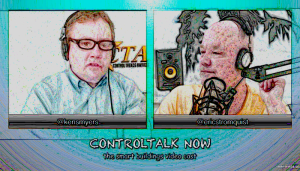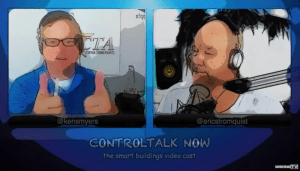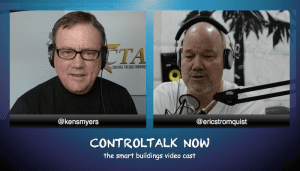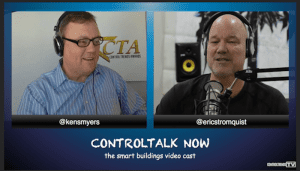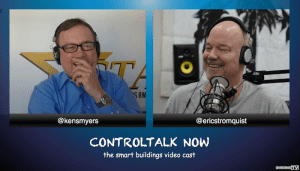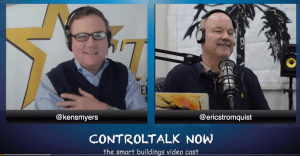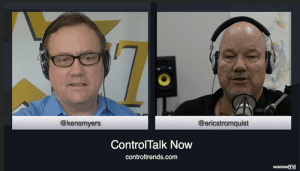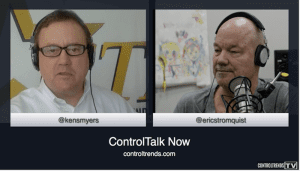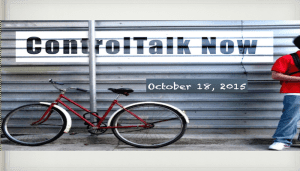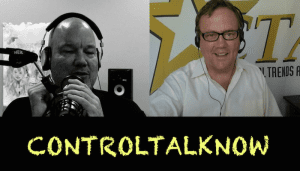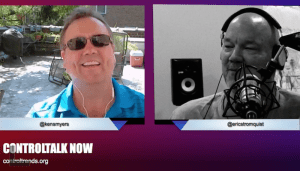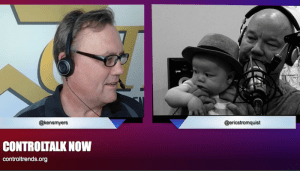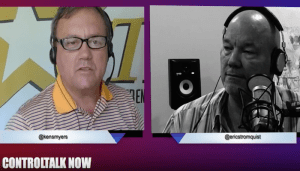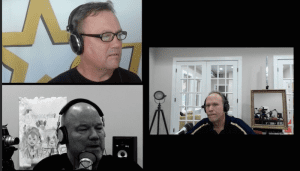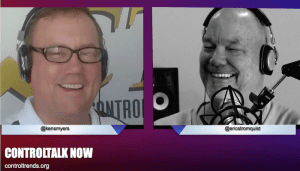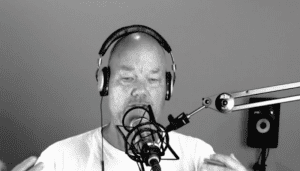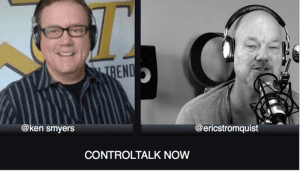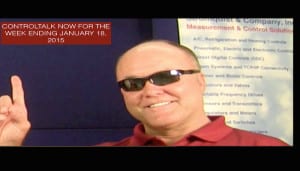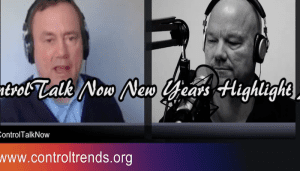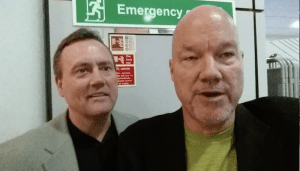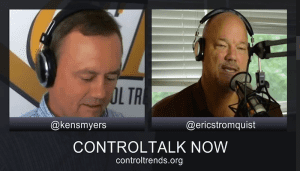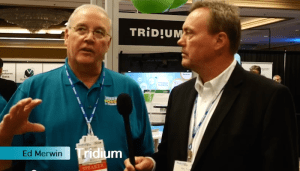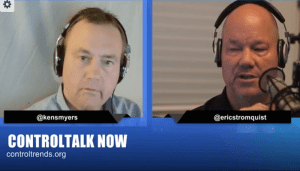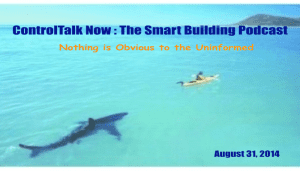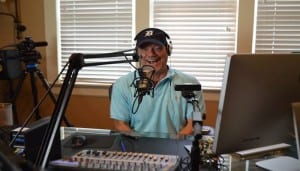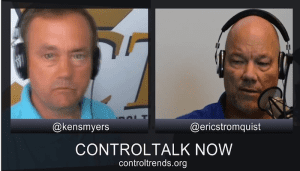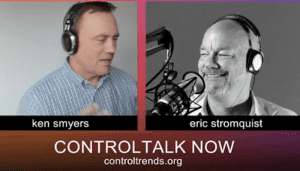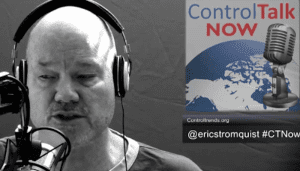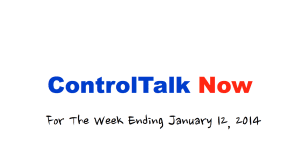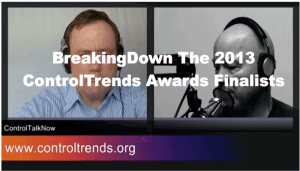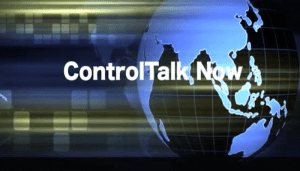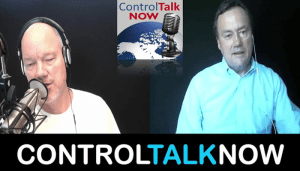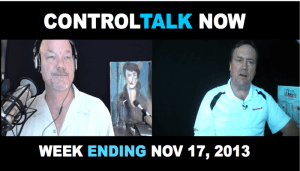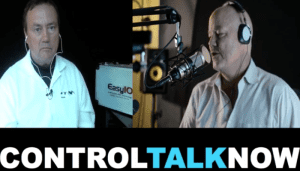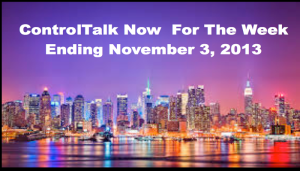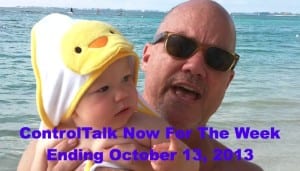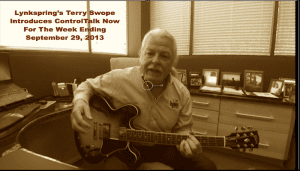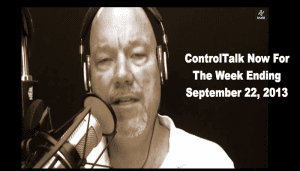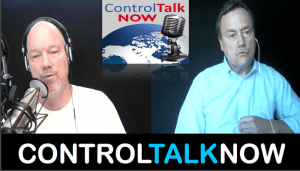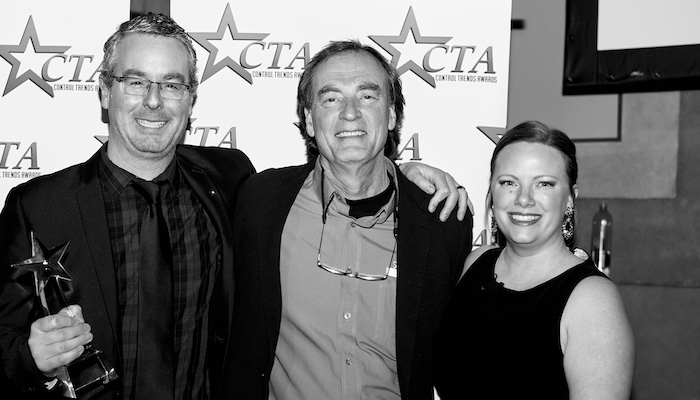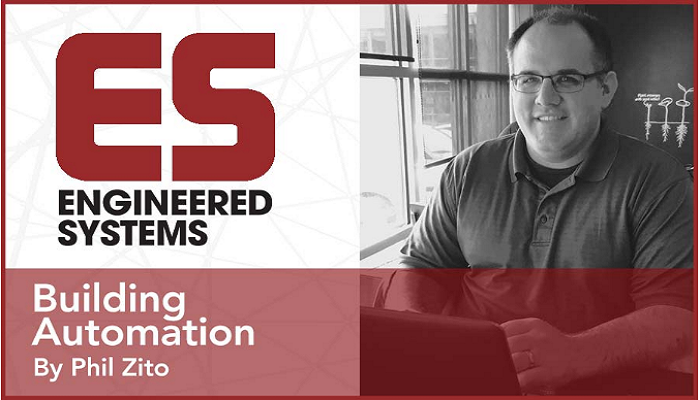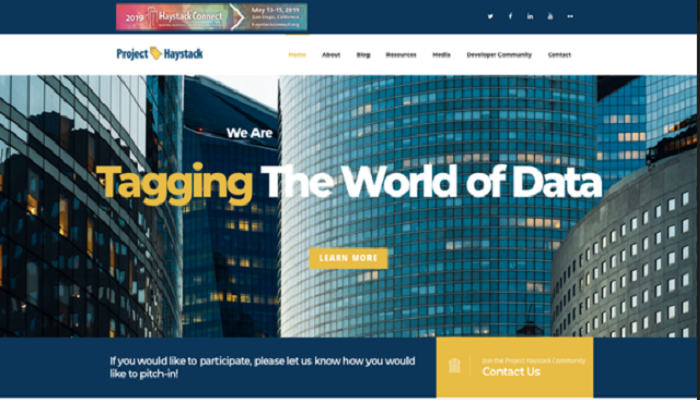Jackson Control leading the way. Integrating Milestone (with Bacnet driver), Honeywell Video, Niagara and Shooter Detection System into one streamlined and functioning threat level management system. Seen here first!
Sun, 31 March 2019
This week's ControlTalk NOW features Ken Sinclair, who takes us on a deep dive through the murky waters of Cybersecurity. The April edition of Automated Buildings is a must read -- as leading industry experts weigh in with critical insights and comprehensive advice on how to eliminate as many of your vulnerabilities as possible. There is a great framework from NIST. Click Here to Subscribe to our YOU TUBE Channel
Our AI transcriber is not smarter than a six year old, so I apologize in advance for any typos and miss spelled words.The following is a presentation and the ControlTrends, Podcasting Network,you're listening to ControlTalk Now. The HVAC and Smart Building Controls , podcast., with the man the myth, the legend Ken Smyres and Eric Stromquist. ControlTalk Now about weekly podcast with HVAC,building automation and Smart Building Control News you can use. Now here's Eric Eric Stromquist: Alrighty. All right man. So cool. What Kenny man, big week. I know you stay busy. I stay busy, man. Roscoe went on in the business world. I think anybody in our industry knows to just kind of like a business has just fallen out of the sky man. It's like how many buckets can you pick up? You know, everybody's scrambling to get the job done and keep up with it. It's keeping us busy. It's a good thing, you know, probably not last forever, but hey, while it's happening, let's enjoy it. Right. I think Ken Smyers: totally right. I think we've come to a, an intersection where the, the, some of the hard work, the pioneer work, the, the, the planting of the seeds so to speak. And then the technology is finally coming into, uh, you know, the, the various modular levels that are affordable. They're understandable. And they're, you know, the ease of installation. And so I think it's a good time, uh, economically too. There's money is available. I know when you talked primarily about HVAC and building automation, you go into certain markets like the mush market, Hospitals, universities, schools, hospitals, and commercial real estate, you know, and the GSA. But uh, you know, the truth of the matter is, is that we've done a lot of due diligence on this and we've proven without question that if you take steps, you know, you fix your worst problem first with the technology. And we've had some amazing products come to being easy. Io came up with the, uh, the FG 32, I think that was one of the mainstays. Then you had to Honeywell, LCB has connect. Then you had the Johnson controls Verasus uh, you know, and you got links spring coming out with the five 34. You have the edge tend to device series coming out from Tridion on. And so all the major manufacturers and vendors out there to provide solutions have taken some of the major product platform and scaled it down so that it can meet the markets that need it the worst. And that's those 50,000 square feet and below. And so, uh, as you know, we keep track of doe and they tell us that there's a, there's about 75% the 80% of the buildings after this still need some love and care and some building automation. Eric Stromquist: So I think what's going to happen with that, and again, at ControlTalk Now, we try to give you control news you can use. So I think if you're planning your strategy now, it's like when the business is falling out of the sky, your strategy nowadays, he'd be just, how can we, how can we capture that business and take it and make money on it? But you will remember this conversation where the man, the myth, the legend told you that 70% of those smaller buildings don't have anything in someone. The economy dries up. You can put together a strategy and go after that. And of course we've got so many great products, companies are coming out with products to address that segment of the market or anything for viruses. Kenny talked about the Honeywell LCBS, well you look at EASY IO, it's great for that race to the small space. and LYNXSpring has a great offering. Ken Smyers: Optergey and LoyTech. I mean we're just, we're seeing the, that we're seeing a lot more. I decided I was going to do, hey Eric, one more time. Could you do that thing you did there about the, you were catching things falling from the sky because you reminded me of somebody. You mind me a Julio Jones. There you go. Eric Stromquist: Oops. Drop it. Manna from heaven baby. Yeah, Manna from for sure. Well listen man, we got a great show this week. Let's go ahead and get our first guest on and then we'll, we'll take care of some business after we getting a motto. How about introducing him? Kenny sounds great. Is the first of the month and you know what that means. Ken Smyers: I sure do. It it that Ken Sinclair from automated buildings have come up with another fabulous addition. Uh, we're going to be bringing Ken Sinclair, owner, editor of automated buildings.com, On to the show. Welcome to the show Ken and tell us about your April edition. Welcome, Ken. Ken Sinclair: Thank you very much. Really pleased to be on a controlled trends. Uh, yeah, our, uh, our April fool's issue is going to come online April 1st, but we all got fooled. And the fact that, uh, I wrote an article for connected contractor that basically linked to the bulk of the articles and uh, it was supposed to go out on Thursday and surprise. It came out on Wednesday. So I'd left us scrambling to, to make sure that all the links were, uh, as, as need as they could be. So we had a release then and a, we're in a situation that we can kind of release that side of it. And I gave you a little piece of artwork and a, an actual article that you can link to that it'll take you to most of the cyber securities. So where this all came from, his Anto, uh, came to me and he had done quite a successful, uh, cybersecurity a session at Ahr Atlanta. Uh, he asked me what he should do and I said, it's way too late. Don't even try and do it. But he ignored me and, uh, and uh, cobbled it together. Uh, it ended up being at seven o'clock in the morning, uh, which actually turned out to be a blessing because everybody who came to the cybersecurity session actually made it. Anybody who waited to come on the bus was stuck on the freeways and mix ms most of our other sessions. So it worked out really well. Anyway, from that, uh, that was sort of the first gathering of a lot of cybersecurity folks and he suggested that we do an issue and we chose April as a month to do that issue. And, uh, I'm, I'm extremely pleased. Uh, uh, it, it makes you realize the giants that we actually work with in the industry. And, uh, if you just flip through their articles, I got to admit, I just learned a whole bunch about the cyber security. I've always been kind of concerned about it, that cybersecurity has the potential of a mobilizing us and uh, I, I feel better about that now. They all seem amazingly enough, although there's five, six, seven articles, uh, all coming at it from different directions, they actually mostly all embraced nurses. Uh, a framework which is great. So we have some commonality. Uh, I just a whole lot of stuff and it's, I think it's going to be a great resource for our industry and uh, I think also it's going to be useful for other industries and it will, uh, it kind of gets our message out, uh, to, to cybersecurity is as general, it maybe identifies us more as it thinking people and helps with that transition. We all have to make really nice job on in Canada. I think this is that this is the edition that you want to print out and save because I think this is going to be something you can use for sometime to come. But anyway, Kenny, I'm sorry for interrupting there. Ken Sinclair: No, that was great. Wedge in on that is the, uh, mark made that comment. He said, this is looking good. We should make this into any magazine and a really the issue, the way we index everything and automated buildings is we never throw anything away. We have our very first issue is still online from 20 years ago, so this issue is Sabre. We'll say cyber security issue will be online for now for for as long as I I chug on. I'm going to talk a little bit about that later in the show. Well, hang on real quick and I guess it one more thing is we've got an April fools coming up. Can I got an April fool's joke? You should play on the community, so on April 1st you should publish that, that republish, that one from 20 years ago just for the, and just see how many people pick up on it. Then you can put that other one back home. Believe it or not, most of the, most of the words are bang on. We haven't really achieved much. We've been talking about a lot of this stuff for a long time. It's pretty, it's actually pretty bad actually. Some of it is. I've actually been doing that in a lot of my writings. I've been taking something from 2015 years ago and it reads great. Well, you know, can I think that shows that you're a precocious back 20 years ago, I think you were when it was first minds in the business, they're really truly took uh, you know, began to document and archive what is likely to come and why and why it's necessary, why you gave us good foundation and you know, you say you gave us where we're at now, where we're going, where we're going to be. But um, you know, the, the way you started off the April edition was you said that, um, I've avoided discussion and the past cybersecurity understanding, highlighting to potential security and privacy concerns can paralyze us for 20 years. We have operated in the wild west manner. And I think that that's, that's exactly right. And I think within this last two years, maybe a year for sure, the compression of seriousness that regard now the adoption, everybody knows their response. Where is a co Co effort, you know, we need to cooperate and collaborate to get things done quickly with cybersecurity. But I mean, just kind of in your mind when you think back, like, uh, was back that for instance, we really didn't have that threat. So I mean, it could have been the wild west and it could be, you know, just, you know, we were naive, but again, the world was different then and I think some of our protocols and stuff. So what's your thoughts on, you know, did you ever have an idea that somebody would penetrate your back net network 20 years ago? Yeah, I think you'll, we were safer back in those days, in the 20 years ago because I think the problem came is when we, uh, started to depend heavily on the Internet and we started to develop a web controllers and all of our devices started to have IP addresses. So what happened is we kind of walked across the floor and we became it people, but not really, uh, identifying ourself in educating herself as it people. When you talk to somebody like Scott Cochrane, he understands that real clear and he's all of his new folks. He's hiring are coming from an it orientation. And I think that's kind of where we're at. I think that's how we kind of created a mess by just, we took the quickest way and I think it was necessary because we needed to prove to our industry that this, it was serious stuff. Ken Smyers: Even doing it badly. Uh, it was amazing what we could do. So now I think we used to have to back up a little bit and clean it up, but my comment was is we have really achieved a lot and we, there's holes systems. Uh, you were talking earlier and in a boat, uh, easy ios session in Amsterdam and easy. I do. I always, one of the companies that was quick to basically move into an Iot, uh, environment and actually almost leave our, uh, you know, so I would call it, flag them as one of the leaders in this. But now we have to kind of go back and take a look of what iot rules are doing. How are we going to make all of this stuff safe in that I have a tremendous concern that if we make too many fences, we're going to be the people behind the fences. That's gets too complicated. And uh, so we have to kind of keep that Claire Claire and I was just extremely pleased with all these talented, uh, cyber security experts that wrote for us. Uh, it, it kind of reads like the WHO's who of a cyber security for our industry and uh, that they all are focused on the Nis, uh, model of cybersecurity and uh, and basically identifying the, the five components of that. And so that's, that's just a great feeling a whole lot better. Uh, my concern, my concern got answered in the, uh, in the, uh, article and actually then at the end of it I just added some stuff just a few minutes ago. It's the trouble with my articles. You think you're finished reading them and then they add another paragraph and added the a a paragraph about the charter trust that Siemens is working for with, and they're there, the Europeans are, are, are sort of way ahead of us, although I'm very concerned that they, they could fence themselves in as they, as you start to, as you start to protect our human rights and protect, uh, our products. Every time you put protection around something, it makes it less flexible and less usable. So they're two opposing forces that we have to kind of deal with. Give me an example of being fenced and cause you use that term, but can you give me a for example, um, for example at which, oh, I see. Um, well just at the same, the thing is so secure. Like the simplest thing is that you have to sign on to everything. And if, uh, if I had to sign on to comfy every time I wanted to use it, that would make it useless. And if I had to, if I had to, every time I went into a building, if I have to give permission so they can use my Bluetooth beacon, mobilizes us idea of the technology, gets it, gets stopped with the so much friction that it would be, you wouldn't want to use it anymore. That's right. And I think there's that potential exists. So I think we have to always be, you know, I am, but what is the reality of it? I have no problem with sort of limiting the amount of information that can be taken off of, uh, an iPhone or Dapa off a mobile phone. But to the proper, the proper manner would be is that it would stop you at the door and say that, you know, it's the whole thing with every website now that's warning you that it's using cookies and you can't, you can't move on the website unless you click on it that you accepted to use cookies. So it's like, do I really need that message? Change your password every time you log on and you can't keep up with your passwords. I'm flock out of so many of my sites for that very reason that I can't remember the password because it made me change it. And then I do three times and then it goes through this massive reset and then you gotta come up with another password and then I just go, okay, I'm not going to be on Facebook anymore. Yeah. Well actually I am running that same thing. Yeah. The thing I've done, I just given up remembering my passwords and I actually, every time I sign on I have it send me a new password. Wow. It's just simpler. And actually for some of it, maybe they've achieved their goal cause maybe that's the most useful. Uh, you know, did you change your password? I had to get it on cause I couldn't remember what it was. Well, you know, they're going to fix it that one day. Ken Smyers: I think, uh, you know it. Then you have that big trust. You've got different people like Google and Microsoft and they'll remember all your passwords for you and then they get to hear that and they get caught. You go to and Ken, I, I thought he came up with another one. I wanted to, I want to make this a, this might be the same when we write something about it. You said that we all take, we all have taken the path of least it resistance. I think that's exactly right. I mean, we all did just what you had to do. I remember the early days we just added for, we asked for two ports. You get me on the network and you worry about it and if I create a problem for you, I didn't mean it. Whatever. So, um, yeah, I mean you said too that the WHO's who of of cybersecurity from our building automation and HVAC industry. You're absolutely right. I go through this, the names here and I missed Fred Gore you the first time because I thought initially and he's, he's like right up at the top that, do you have a Anto? You got James Lee, you have Fred Gordy, you have Marc Petock, Ping , and you have Teresa Sullivan. You have just, just how many Kevin Smith's different CTO from treatment. How did you get all these people involved so quickly that you could put this together in a monthly addition? I mean, it's, this is a lot of network. Ken Sinclair: Well, I got to, uh, Anto helped a lot, but as I mentioned that a lot of it, a springboard off of the, uh, cybersecurity session in Atlanta. And actually that whole session is on the new deal site, actually is as much information as there is on the surface. There's, there's two documents. There's, uh, a report I wrote to try and put pictures and English subtitles to all of their complex articles and then linked to their articles, sort of give you some, uh, so you can get up merge and get up to ramp speed trying to get your mind around all of this. And then secondly, uh, Anto and I did a discussion, just a, it's like an interview, but we did it in the form of an article and we basically talk and link to each one of their things and sort of talk about the evolution. Uh, and of course this'll, this'll also get fed back on the new deal, uh, website that, uh, uh, okay. Anto maintains as well. Uh, symmetrics has been a real supporter of this. Uh, and Oh, the other one you missed. Uh, the other fame to more famous people are, uh, James Butler basically talks about the new, a BACnet, BACnet secure, I believe it's called, and an Ping of Optigo Hook, Ping Yell. And then I miss Deb Noller and, um, Jim Butler, Simon. But I just definitely, but it's an incredible lineup. You're quite right. I, I too was impressed and a, I think what happened is that is once, once they found out that somebody was writing, uh, was easy, when I reached out to them and told them this was our cyber security issue and we have some pretty good traction, then I think they, uh, they wanted to be part of it. They wanted it to be identified as a part of the solution. But the amount of information there is just phenomenal cause you, you click on any one of those, uh, industry experts, you get down to their site and then they give you their links and then their links give you more links. So from, from this, uh, I'm really proud that from this one page or this interview, you can, you can probably even go down the rabbit hole. Yeah, you could read for two weeks. But the good news is, is when you start reading it, there starts to be some common themes and some common cautions. And, uh, it's not like everybody's saying, uh, you know, do it my way. And that's, that's what the holistic cybersecurity is, is that we've got to do this as a group. We've got to do this as a, uh, a community of practice. And of course, that was our last thrust and it fits really well into this. And in fact, at the end of our, of the article, we actually identify a whole bunch of communities of practice that are, uh, that are, are, uh, are accurate, are evolving for cyber security. Right? Right, right. No, I like that. Conceptr, but that was it. Was that a Therse Sullivan a concept? Yeah, actually that Atlanta was pretty significant for us. We're saying, we're still talking about it. Uh, um, we did the, uh, it was called the evolution of a automation from ether net to emotion, our session. And we basically went back and we talked about, you know, the overview that we had prepared. And actually this is going to be part of my keynote at control con is that, so I've been 50 years in the industry, uh, 20 years of that is automated building. And, uh, so what, what does the old guys see? Well, what the old guys sees is that we went through a whole lot of technologies on our way from pneumatics to AI, but, uh, the only constant is the people. I mean, there's pets. He's there in the beginning and he's still there in the end. Leaves there in the beginning, uh, the beginning of backnet them and James Lee in San Francisco and the first backnet integration with train that gotta be 30 years ago or something like that. Ken Smyers: Uh, all of this stuff is, has radically changed, but these people are still there and the people and their communities of practice are, well, it's kind of keeps us moving forward. So I'm kind of intrigued by that. And of course, uh, the, the events that are coming up, we're all kind of part of and they become our community of practice events. And uh, certainly that's a ControlsCon is certainly one of those events. The next one that I actually used as an example in that article is aHaystack Connect because HaystackConnect grew. You guys were there in the beginning, you saw how it grew and you saw where it's grown to today. And it is certainly a community of practice when you actually attach yourself to these communities of practice. There's so much information and so much resource because there's very talented people and we're all working on a common theme. And the other thing that comes is communities of practice beget communities of practice because once you start working with this, we've got an absolutely new field. Um, maybe like a camera AI or something like that that we're moving into. We don't really know anything about it. The fastest way we can get from zero to, uh, highway speed is how along the ramp is basically catch on to a community of practice and join them and basically look for a while, find out what the heck they're talking about. And then eventually we'll get up to merge speed and we can actually drive along highway with them. Yeah, it makes so much sense. Can I'll begin by just going to go it alone. And this sort of gets back to a concept that a, either you or Kenny coined about the Co- competition, Speaker 5: whatever it is, co option. All good, Eric. I'm just don't know which analogy which one they'll get doing the random, in other words, we've always said that it's for our community and for, for the building automation world. HVAC I'm ever you, Eric and I were down with Marc Petock.. We said, where do we go? What's, what's our, what's our course of action? And Fred Gordy came out of, uh, you know, he was the champion and he was working with Billy Rios remember. Uh, yeah. And then next thing, you know, uh, it just started rolling. This big wheel started taking roll. And now looking at this litany, this, this faculty, you know, again, Deb Noller, Jim Butler, uh, ping a poke, Ping Yow, uh, Mark Petock, Kevin T. Smith, Fred Gordy, Anto, but Yardo Vr, Joel and James Lee. I mean, now we've got a faculty and then use that with nest. And we've got real great direction that we've gone from having little, uh, you know, kind of guidance. And what do we tell people? Remember that that checklist we hung up on the refrigerator with Fred Gordy. We put his, uh, 10 best things to start a cybersecurity if I get an internal champion, et Cetera, et cetera. But then, um, so it's really good to see that what you said with the ramp to the highway. In other words, we got people onto that. They can finally get a, onto a ramp and started learning, like you saying, and put, put things into context, you know, deciphered, filtered for themselves and their organizations or whomever their businesses. And then, uh, you know, keep at it to the point where you could get onto the ramp way in, merge onto the highway and be comfortable and be professionally competent in cybersecurity. I think it's a great analogy and I think he had a lot to do with Ken. actually Scott Cochrane and I had been fooling around with it as well. And uh, uh, my comment to him as I was appreciating what Scott was doing for me cause he was, he's, he's pushing me along the, uh, along the merge ramp and uh, he wants me to get up to speed before I hit this uh, conference because, so I don't become roadkill. But they, then they, then they were very polite. They re they redefined me as the road warrior. Eric Stromquist: I like it. What, do you guys ever hear of a book called think and grow rich by Napoleon Hill? Yes. Okay. So you know what it reminds me of Ken, and I'm rereading the book is as you know, cause he interviewed Andrew Carnegie and all these people, the successful traits of people that are successful in the top in their field. And one commonality they had as they all had a mastermind group of likeminded people that weren't what they would bounce ideas off of each other. And you know, part of Carnegie's thing was it no mind, no matter how good it is, can capture and understand fully. So, you know, it's almost like these centers of practice are also run me a lot of Carnegie's mastermind groups. Ken Sinclair: Yup. Yeah, I think so. Very, very much so. Uh, I mean it's a way we organize their life. It's kind of funny that, uh, when, uh, teres definitely I would have to credit her to, to basically putting the words around the community of practice. And then she went digging back into the history of how that kind of came to a play and then she put it in one of her articles and then I've rewritten a whole bunch of other stuff on, on that. And you're quite right, it, those come right from the, uh, from motivation. And, uh, but it's just a quick way and it's certainly, I mean, if you want to learn about anything, if you want to learn about video equipment, I'm sure you belong to sub communities of practice for video equipment. I mean it's, and especially with the Internet, it's just so, uh, probably burnt and, uh, everywhere so we can actually get this information. The other thing we've identified a is in talking to my young guns, my young editors is we, you know, he floated out the question is how did you get so smart? And they all came from various backgrounds. Uh, but how they got smart was they basically educated themselves and they learned what they needed to learn. And that's really the model that our whole industry is evolving on is, uh, it's, it's just so broad that, uh, nobody can tell you what you need to know. You just have to pick a, a threat of it on real quick with that because you know, I think, you know, you, you and I both had this concept of, you know, take a millennial to lunch or whatever. And you know, I've got two mentors, one them moves in his seventies and one of them who's in his late twenties and you know, we've heard him manufacturing, I'm throwing this out primarily for our manufacturers who are trying to train to get traction with people with their products. But you know, we've heard just in time manufacturing, right where you just build it at the last second, but with this cat's about, and what the millennials are about, it's called just in time learning. In other words, if you give them a manual, they're not going to start at chapter one and go all the way through. They're going to hop in where they want to hop in and then they'll go around it however they do it. So, and I think in a way that's a lot better, uh, I think they can get up to speed a lot faster and they're willing to make mistakes along the way. But for guys like me and you and Kenny is like, no, you start on page one and well, you know what the Eric, your, your your point. It's so true. Uh, in other words, we're seeing this, uh, I took a look at some of the new education going on in, in public schools and grade schools, and then we're not a young students are not learning how to write cursive anymore and how it's been antiquated and how it's a, it's a barrier to learning enhancement learning. But if you talked about the community of practice, can, you know, you had, uh, you had, uh, an initiative back when you were doing your collaboratorium that was kind of, you were creating that, uh, that exact community of, of, uh, you know, practitioners that were the experts. And then, and then to your point, Eric, you're absolutely right. Just in time learning. In fact, remember Ken, you did the didactic you were talking to, you were the first person that I read the didactic. Ken Smyers: I said, I just use words. I can't say. Yeah, yeah. You, so you said that what's going to happen is we need to put all this stuff into some sort of forum that's available and it has the archives from a to z and then that anybody that wants to learn really quickly can, can enter any part of that, that 20 year swing that you put onto your website and pull down meaning from it, and then just learn what they need to learn to get by the next thing. And Eric remember, we did a thing with a wearable technologies, how they said it's the only way they're going to keep, you know, to produce results in the medical fields and the gas and oil fields. And now we're gonna see it. You know, building automation is, you're going to have a home base and the rest is going to be camera and somebody at the site's going to be to say Turner wrench to the right. Three quarters turn. Good. Stop. Okay. What's, what's the pressure reading again? Show me, you know, so that that's the way the world's going to work because you just, you won't be, you won't have the luxury of time. So it's more efficient. Right? You won't have electric, can't get a semester's worth learning anymore, you know, so you can't read the preface and the epilogue. You gotta just get to page 38 were, tells you how, but with a point of dinner is made now knowledge a very democratic in its not for the, the fewest for anybody that wants to learn can learn, which is the really exciting thing about it. And so for our community out there thought cybersecurity was out of your purview,Ken Sinclair, begs to differ with you. Just go to his April edition and you can be a cybersecurity cop, Billy the Kid Rios. Ken Sinclair: Good stuff. Okay. The other thing I think we have to look at is we have to look at a ControlTrends.com is definitely a community of practice and a, your company as well, Kenneth and automated buildings is a community of practice. Uh, and it's interesting that, that you go into these communities of practice and then inside of each community of practice is a unique one such as Haystack Connect is inside of that and inside the haystack is a sand star, uh, community. So all these little communities are the mosaic that, that build us. And if you want to get going fast, you have to just, you have to go to the community that you need, you need to interface with to do whatever it is you want. Once you get to that community because they're all online. The other thing you didn't mention about how the young folks learn is that we, uh, they can just send out a blog message and they just ask. They just say, I'm trying to do this. I've read, they always have the politeness that they've read through everything the community has talked about. And somebody said this to even pick up on a piece of that and said, I need more information about that. Then you'd be unbelievable. The whole community jumps in and helps them. They're very collaborative. I think we grew up in a time where we, we kind of, we had to do it on our own and we were very proud of that machiavellian Eric Stromquist: my number, can I, how I'm going to take another step out of it was a competitive advantage to know something somebody else didn't know that Internet changed that. So the youngsters who are coming along, you know, you know, good blind horse, why hoard information, but back when, back in the day, I mean, if you knew how to calibrate something, somebody else didn't, that was your differentiator in business. But knowledge now is, uh, I just keep saying democratic. Can we get gimme the vogue vocabulary word for it, Kenny, that, uh, where it's a ubiquitous or, uh, that was, it's not for the democracy of, of, of what we're doing is basically, it's, it's, Ken Sinclair: yeah, it looks I know what you're saying, Eric. I'll think of it in a second. But you don't see, knowledge is no longer elitist, right? Well, you know, you, you and I went to Scotland at one time and that's where it really hit me the hardest. I mean, uh, the, the way the cat gets out of the bag and the printing press and, and when they said that the one, the rich benefactor for Edinburgh said, I'm going to make everybody learn how to read. And he paid for it and he then suddenly children were learning how to read and write and it went, it went backwards on it. Instead of reading right in the Bible, they became political. They, they came politically unrested but to your point, a printing press changed everything because I had knowledge and, and so I think that was, that was step one. Step two was probably the Internet, right? I mean, wow. That's, I think that's the analogy I was trying to make is that the Internet was designed for certain things and all these processional items you work per session. We have no idea what's going to go. In fact, I was reading an article the other day about apple and some of the other people, uh, they're thinking they've gone to a, met with the president and they're talking about re organizing the United States, his approach to education because we're so we're falling so far behind the world because we're playing all these education process leads to a dead end. It doesn't lead to fermenting exciting people. And they want people to, you know, apple, uh, executives were explaining, if you let these kids play with technology and they take a tech technological path that they're not going to be interested in geography or history, they're going to be at their aptitude, say, let me play with his stuff and learn how to program. So the whole thing is to how do we get more programmers and how do we get that step, you know, the sciences, the technologies, you know, how do we get people involved in anymore like they did back in the 50s when we're having this space race. You know, all of a sudden we produced massive amounts of engineers, mathematicians, physic, uh, you know, uh, you know, PhDs in physics. And, and just, you know, because of the educational process drove in that direction and led to outcomes that we're producing. We're engineers. So we're seeing this come up, uh, you know, our whole Orthodox approach towards education is being, is being reevaluated. Ken Smyers: What about in Canada? Again, Canada, Canada, is it, is educational system really geared up towards the sort of technological revolution? Like, you know, Ken suggestion, we're not necessarily doing the stakes. Ken Sinclair: Yeah. Not where, what's going on in the states, but I'm actually reasonably close to like local school because we've got a granddaughter. It's a great, uh, six and uh, and yeah, they, they use the web a lot. Uh, basically, uh, what's going on is on the school, there's a class website and basically what's going on, who's doing well, what events are coming up. Uh, that's all that's all documented. But to Ken's remark, I wanted to, wanted to just say that when, when we started in this industry, you guys probably had a better idea than anybody cause your fathers were in the industry. So you followed your father's in. But for a guy like me, I mean I'm on the farm. Uh, and uh, it's pretty hard to imagine what I'm going to be when I grow up. And also information is very hard to come by and to try and discover your passion. Uh, it just sorta has to evolve. And you basically, the first job you took had a lot to do with where you ended up working. Uh, now we have the situation that you can spend hours, days, years, uh, surfing the web and you can find something that is incredibly intriguing to you. And then you say, I'd want to be one of those guys. And then you start learning that from the community of practice. So it's, it's kind of that, that thing has been completely reversed. If you think about when we came into the market, what are we going to do? Uh, now the kids can, they, they've all got a good idea what they want to do because they saw something on a youtube that looked pretty fun. Well said. Well said. So tell us some more by controls. Come for a minute because you're going to be a keynote speaker up there. Uh, would you be giving it away if you tell us what you're going to talk about or, or, and if our community have to remind what controls Khan is and why they should go, how by giving the, the sort of the Canadian elevator speech, if you will. Okay. Okay. At Scott, he involved me in this and I, I frankly, I got to go to admit that when he asked me, it was like, you sure you want me? Cause cause it's a, it's a systems integrators, uh, uh, meeting is, that is the gist of it. And every time I talked to the systems integrators, they're doing more than I'm writing about. I, I have this perception that I'm on the leading bleeding edge. And, uh, uh, every time I talked to someone like Jason Hoc, I'll, uh, uh, yeah, I find out a whole bunch of stuff they're actually doing that I haven't even thought of or haven't wrote about. So, uh, I was, I was wondering what I was doing there to get up to speed. So I think what I'm doing there is to just maybe a, explain the, uh, the perception of time, uh, and just the whole, you know, 50 years in the industry who actually seen an industry go from pneumatics to a AI and just seeing all of the people, uh, part of it, uh, I think the other message is, is that we're all struggling, uh, great. Now to extend our best by date because the technology's changing so fast. We become obsolete and moments. And my only the fence for that is to, uh, basically grow younger and I've found out how to do that and how to grow younger is basically to look at all of our problems and stuff through the minds of our young mentors and, uh, who have grown up as digital natives. So I think that's, that's sort of the gist of the message is too dry and do that. The other one that is, I'm, I'm coming around to is the fact that there are a tremendous amount of women in the wings in our industry who have basically been a personal assistance for powerful people. And they have an amazing amount of information in their minds. Uh, and some of them don't want to be mainstream, but that doesn't matter because they can be very useful remote. Ken Smyers: So my reach out the episode is out, uh, this is a potential for our industry. Probably within your companies, you have exactly the same thing as somebody who's been quietly sitting over there in the corner and has been, you know, organizing all these products and stuff like that. They have a tremendous amount of information and they can actually be very quickly on leashed in a AI or a machine learning type of environment and they can be, uh, very quickly get us up to speed. So I think we're all looking for how can we get new people into the industry. So those younger mentors combined with our younger mentors. And uh, and the other comment I always make is anytime I talked to my younger mentors, there are comment back is they say, you should see what these kids are doing. They're looking at the next generation. And these are kids, I dunno, there, I call them digital natives. I don't know what, uh, these other ones are like a digital, maybe digital immigrants, let's call them that. Digital immigrants. They basically come from a world that they don't know. They don't know reality. They never, they've never experienced reality. They've only definitely I to tell you real quick, uh, yesterday I'm driving home from the office, you know, coming home and it's Friday and Fridays are my favorite day other than Saturday his, but anyhow, the phone rings. It's my daughter calling from San Diego, I think. So I hit the button, hello? Hello Lo. Nothing's there. I can hear noise in the background and I'm like, what the heck? You know, so I got a little concerned so I hang up my call her back. And by then she rang regain control of her phone. Her five month old daughter, my granddaughter apparently picked up her phone, not even really picked it up. She said she was like, she was, they hold the phone to her. We do so many of these, uh, you know, whatsapp videos. We get to see credible. And so the technology, I'm like you, I love every day that there's something new going on because I still can't, I pinched myself to think of how crazy, you know, this iPhone is and how to talk to Germany and I pay for it. And it sent a video where after you to take, or to shoot it live, it's just, we got to, you got to do more of it. And, and, but um, you know, five months old tap in the phone because she's been put it in front of her all the time to show, you know, grand the grandparents in Pittsburgh with what's going on. So they do a video. So she's so used to that phone being part of her environment that she's like in front of a phone and then they, we reversed it so she could see what we look like. You know, we keep saying the same thing to her that she could recognize our voices. So, to your point about the digital native, I mean, we have no idea that somebody, uh, as a, as an infant, you know, learning about technology and playing with technology and not reaching for things that they don't have to reach for. , people don't want to get out of their chairs anymore to run over to the thermostat and turn it up or down or turn the fan up to speed or whatever. Or to dim the lights or to close the blinds. I mean, why should they want to just hit their phone and say, you know, boom, up, down, cold or warm or whatever. I mean, and, and to have that mentality when you come into your workplace and to see where we're, you know, state of affairs. And one more thing can I loved you said about the best buy, best sold by and the shelf life. So where do we sit in the scheme of things? We're, we're like the canned goods up on top of it. Shelf, don't eat, don't drink this milk. Yeah, I got a kick out of that. Anyhow. Well. Yeah, I titled, I think I'm going to title my, uh, my keynote is the next 50 years. So as you can imagine, that might be a stretch for me. But anyway, back to the other comment about how the, the digital natives or the, uh, the digital immigrants, I think I liked that. I think we should call these the, the next, the next wave. We've got the digital natives that are pretty comfortable with all this technology, but the digital immigrants are these kids that are coming up now that have they lived, never lived in a real world. They've only lived in the virtual world anyway. When they, they looked at your problem of raising the blind. I mean, the first thing they say, well can't they just talked to my whatsapp and say, what's that blind 50%? And it knows by where I am that that happens. You know, like why wouldn't you just do that over all of this stuff? They don't, the newer group is not the digital Emeris Ted there digitally and titled Digital Trust Fund Babies. But your point, I mean, the more we learn about it in our, our realm, the other day I had to convert a bunch of Celsius to Fahrenheit and I did the old nine over five and I'm thinking, what am I doing? So I just said, Hey Siri, what's 50 degrees centigrade? The set points, you know, whatever, boom. I mean it just came right back to me, you know, told me the degree is 120 degrees or whatever it wasn't and I thought, or 170 whatever. And I'm thinking, why is my brain not letting me access and avail all this technology? Why am I so, you know, determined to do it the hard way. And I think it's just conditioning. So the two year younger mentorship and having somebody aboard, like you were saying, Eric, you know, it's just to remind you that you don't have to do it the old school way, that there's a option and the option might save you a lot of time about energy that you can get more done, more efficiently. So that's kind of cool. And then the kids taking a picture of everything, hey, you'll be writing down a number or something. They saw something you want to buy or something on a thing and, and they look at you and they go click, click. I wouldn't, why, why would you write that down? Right? Why would you do anything? And of course the other thing is, Oh I actually, I got a good story about that. We were uh, we were lost in the train station, then a Roman, our ride was trying to find us and that's what he said. You said just hold your phone up and take a picture of where you are and then I'll know where you are and Oh, you're on the other side of the term when all he said, as soon as we send them a picture. So basically he's on whatsapp and we took here's a picture and then he knew where he worked cause our English or Irish, Italian wasn't that good. But uh, a picture's worth a thousand words. You're on the other side. You're not, you're not on the right side. You said, I'm just going to park my car and I'm going to come and get you. Yeah, I probably at that same spot. You are a canon. Not I want to go there. You were carrying stuff the baby buggy and are no cars. Car seat. What all do you have? I saw the picture that I'm glad I didn't have to do that. Oh Man. I'll tell you what Ken and almost kill me. What their travel with the small kids and my wife's brother, uh, had a destination wedding and then on top of that it was black tie. There was an extra suitcase to carry all the, the black ties and do, it was just, it was nuts carrying luggage around. But anyway, I survived. I'm better for it as Nietzsche said. What your wife does doesn't kill you, will make you better. I can't. So we get, we'll see at haystack we will see you. Uh, obviously a Cochran, uh, April issue is out automated buildings.com. You definitely want to check that out. What don't you got before we hop off here? My friend? Well, I guess we'll all have to put her Elvis Skosh Shims on and go to real calm and Nashville. Right? Eric Stromquist: Absolutely. You're going to be down there for sure. Right? Ken Sinclair: Yeah. Yeah. I wasn't going to, but Scotty talked me into it so, oh man, I'll never forget it. Yeah, I'll never forget the time. It was so much fun and hopefully you'll do this with us again was, well I think the last one I saw you, I was a maybe San Antonio, but remember you and me and Theresa and Kenny, we'd always do our day one, day two recap. So cause we can't you on and being a recap or with this. Sure. That sounds good. Yeah, it looks like a lot of stuff going on there as well. Actually I in my never my never ending article, I also tagged on a uh, their cybersecurity a day before event that's going on as well. Cause I thought that was a kind of fit in, well with this whole cyber cyber security resource. I'm kind of trying to kind of put this thing is it's just a link to where everything that's sort of happening in the industry. And at the bottom of that is I've got these three events we've just talked about as well. So, Hey, I do, I'm going to say one more thing before I forget. Uh, controlled trans for anybody out in it's still not, has not yet signed up for controls con 2019 it's May 2nd May 3rd in Detroit at the motor city casino, we have a 10% discount. If you go on now to the website and you register and you putting controlled trends under the discount code, you get a 10% discount. And also with real calm, I be con 2014, June 11th through the 14th down in Nashville, Tennessee. We also have a ControlTrends.com Discount 10%. Uh, and, and when you register, you put it in and it gives you, actually, you have to go to our website and get the discount code. So I'm sorry it's not, it does not ControlTrends.com Is the ControlTrends discount, but there's a number, a little code you put in there and it'll save you 10% so you want to put that plug in there. Eric Stromquist: Excellent. All right, I can't send ken Sinclair, Automated buildings.com check it out Ken. Thanks so much as always man. We can't wait to see you next month and if you have something in between now and then don't be a stranger. Okay. Alright, thanks guys. Great stuff from Kensen queers always in. Hey Man. Yeah. We even talk about all those other great articles that are on automated buildings.com. So be sure to go to check out automated buildings.com the April issue cause there's a ton of other stuff on there. And Man, speaking of phenomenal stuff, our man Mark Pete Talk, in addition to being the master of ceremonies of the controlled trends towards, in addition to being the guy that broke Cindy Crawford's heart, New York City back in the day in New York City when we got started in advertising now he and the team at Lynx Spring had been acknowledged by frost and Sullivan. Kenny, I've got to get this right so I'm actually going to do, I want to read it. 2019. Global Iot and smart buildings, customer value leadership award. Way To go, Terry Swope. Way To go, Bob [inaudible] way to go. Mark p talk way to go. Everybody at the Lynxspring Group could get group of guys. It's nice to see that frost and Sullivan is acknowledging them. Ken Smyers: Congratulations job. It's, uh, well the, uh, the big phrase to eat, to eat platform provides exceptional service delivery and value enhancements through a well synchronized suite of solutions to ensure timely integration with a smart building infrastructure. And it has earned his stripes and, uh, congratulations to a very successful team with a lot, a lot, a lot of motivation, a lot of passion, a lot of initiatives. So they, they basically took that product platform, uh, from over here, kind of an obscure location to a front, front, front vendor position. And, uh, it's, people are asking for it now. So, and listen for our young guns, you might not know when we talk about Cindy Crawford and mark in the 80s, there was an error of the supermodel, Cindy Crawford, Linda vaginal, sleazy, Naomi Campbell and all that. And speaking of that, you know, I just got a, there's a text on the Facebook messenger here from a see Crawford going, how old are married now? Hey, mark, it's me, Cindy Holler, whatever that means. So mark, you'll just do what that, what you'll do with it. So one more thing. I just want to say that, uh, you know, much of the technology is available through the built environment, depends on systems integrator. So link Spring Pa did the channel of approximately 250 systems integrated partners throughout North America and a few select international countries to support the built environment effectively. So again, well done. Well done guys. Well I'm for sure I Kenny, what's, what's gonna be our deep dive posts of the weakness acres. We've got a bunch of them. Well, I took the uh, but we can only do one. Well I think what we have to do is we have to say that, uh, you know, one of the biggest hit posts that we've ever seen of all time was the two way three way valve diverting mixing and the second largest, uh, post performance was on gas pressure regulators. And you did a nice little, a presentation from the HVAC Tech SChooll from HVAC Tech SChool Play list,. gas pressure pressure regulators made easy. So tell us a little bit about that. I think that was posted the week. Well, thanks buddy. I appreciate that. So we got to go back to what we've been telling our community a little bit that we're really torn up the youtube channel because we get more content up there quicker. So might not always make it to the control trans.com website. But uh, so we, we created a playlist of you will called HVAC Tech School, this on the youtube channel. Some of these make it over to controltrends.com. Not all of them, but yeah, the gas pressure regulators made easy, uh, you know, how to install them, how they work. We actually take one apart so you can look at it, see how it works of your answers and gas regulators at all. And apparently there are a lot of people who do, you can check that out. It's actually on controlled trends as well as the controtrends, smart buildings, youtube channel. So I encourage you to subscribe to that if you haven't already. We'll put a link for that in the show notes. So that's a big one in the two and three way valves. Again, sometimes a picture's worth a thousand stories, a thousand words county. So we know we're trying to create video content that takes some of these concepts that can be complicated and make them really simple and we'll build off of those. So we're going to keep putting those up on the youtube channel and then, well no, a lot of them make it over the controltrends.com Website too. But another massively hit, and this is only available on the ControlTrends Smart Buildings, youtube channel is the midweek review, which uh, one of the smartest guys here on the podcast a does, which is Ken Smyres. So talk about the med review again,Kenny. For our listeners who might know about that and tell them what you do on that and why they, why this is disrupted. He usually do youtube channel so they can get that. Well I appreciate that Eric. I didn't have makeup on a day. There's makeup squad wasn't around so, but you know what I want to be because if you are where big trouble, I was just trying to say something it on there because that was a fast and furious post and the reason why it's like you said, we had so many dates that were coming closer to windows where you had, you know, sign up by today and you look for, or you would forfeit the opportunity for a discount, whatever. So we had the midweek review is to give somebody a three to four minute synopsis of all the industry events that are coming in the next 60 to 90 days except for our Smart Building ControlTrends Awards, which is going to be February 2nd, 2020 but tomorrow when your calendar in case you're driving somewhere and you listen to the show or whatever and you have an opportunity or you're, you're, you're listening or you're watching but you don't have a whole lot of time trying to give people a synopsis, a real short sweet list of what's going on and where it's at and what the dates of signup are. So you know, I covered the, the, the controls con coming up May 2nd, third and we controlled trans as a discount coupon there. So if you go onto and registering, you putting controlled trends, uh, we have the CIO event coming up in Europe and we'll be putting a post up on that too. But there's registrations and you take advantage of them. Uh, we're going to put some other information about the travel costs, whatever, just to lure people into a different alternative vacation this year because you'd kill business and pleasure in the same event. Uh, we have the project haystack out there in California. The, the, uh, what's that going to be? That's the 11th through the 13th, I think. Right. But that's why even I have to refer to it because there's so much going on. And then you go to the 19th through the 21st is the CIO and Amsterdam and then you turn around, you've got a real calm, I become in June leverages, so you're doing the conferences, but you're also doing it. And to Kenny's point, what, what, who is trying to be as on Wednesday afternoon, you can take that, that you can just click on that video, you get an update. But things like if there's a recall, if there is something going on in the industry, if there's a cyber security alert, something going on with Niagara or something like that where you need to know something immediately, what we're trying to do is just make it easy for you to consume. That could control is unique you can use, right? And so Kenny does a great job of that. So it's not just conferences, it could be a new product release, it can be news you could use. And I think that's the point of a Kenny just trying to break it down short, simple, sweet. You go to the youtube channel, you quick on this actually if you did the youtube channel, you just cooked a little alarm button, you'll be notified when this comes out. And uh, so he can hit on that. And then obviously on controlled trance.com you get this show, the long winded version. Well, and then when we take our time and we make it happen, Eric Stromquist: I'll speak into the long winded version. Uh, what can Steve jobs teach us about the smart buildings controls revolution. Now I got to kick of the stretch you made there. But actually after watching that again, cause I had watched that before, you actually did make sense about what it's all about. The marketing, how, you know, it's taken for granted. It's a critical function, but it's changing. It's evolving. It was infused with social media. And if you didn't handle it right, you lost, you lost a lot of your mainstream. Uh, but today you send papers out in the, in memory, so much marketing, it wouldn't even open up the envelope. You literally just took it from your inbox to the trashcan. So those days have certainly changed. The people don't like to take catalogs anymore, whatever. So we were seeing the thumb drive, you know, uh, became the big thing. And even that, starting to, I heard a, a vendor tell a group of people that were looking for, they used to get thumb drives every time they had the presentation. I guess there's no marketing says you've got to go on, go on our website. It's all there. There's no sense putting them into these um, drives. Cause as soon as we get them done, they're obsolete because they're old and antiquated and we've added new products and it's not serving the purpose it was intended to. Well listen, I encouraging of the website is so about a five minute talk that I've found that Steve jobs did and many considerate the greatest marketing message ever and it led to the one what many consider the greatest marketing campaign ever. And like I said, rather than Kenny and give you our take on it. I mean it affected me enough. I just went, holy smokes made so much sense in my, what I'm basically saying is, hey listen to it or watch it. I should sound control with each on comments. We'd love know what you think. But I think there's so much wisdom and just how, cause he's basically addressing his, his stockholders and then staff. Right. And, and it was a radical concept as he's addressing them. And that you kind of can almost hear a pen drop. You're kind of going, well, they're not going to like this. And you kind of starts out and makes a statement and he kind of goes from there and by the time he's done with you, you're going, and this too, just got it right. So it's not necessarily what you think about is how you think about something. And I think that that message carries forward to our industry. Every single one of our companies in our industry, I think can learn something from, from this. So please check it out if you check nothing else on Controltrends.com site and check that out and reach out and comments. Let me know what you think and, and Kenny what you'd think. And Hey, you know, we'd love, we'd love to share it. I thought no, it was, pardon me. Putting that up here is, I think this needs to be not just a post and needs to be an ongoing dialogue and needs used to be a dialectic. There's my vocab word for the week, Kevin, that we carry forward as an industry that, that helps us hall, uh, as we move forward in this incredible industry we're involved all involved in. Ken Smyers: Right. We had one more shoutout section here and just the, our Linkedin, you know, the, the folks that say good things about us on Linkedin and, uh, some congratulations for birthdays, a Adam, I'll pull grab ya from Poland. He's the chief Ito Iot, Bam. B a s P, m, a s h VAC executive, uh, says a, you know, he's watching our controlled trends. We've got Travis curr had a birthday. Uh, he had a art hicks had a birthday. Darlene pope changed job. She now works with the, we work. So, uh, Darlene and Lindsay Baker together. Oh Gosh. Yeah, yeah. Two of the brightest women on the planet together. Whoa man. We want to come to, we works and we've got a worked in Hershey Holler. Well, you don't have to cheat. She was always, she, she, she fast tracked everything. You know, she was really smart. She was just a great speaker. I remember, remember how we got involved with her? Uh, she went to work with the Jones, Jj, Jj Jones. Lang Lasalle. Yeah. And so, uh, well she's just a, she's burning, burning, burning to the ground here. It would probably say here, hopefully see her and Lindsay at Haystack, uh, connect, but hey, good. Seriously. That would be a great show Lindsey. And uh, and I know Darlene on at the same time. All right. Then real quickly we have worked anniversaries for Eddie Turner, uh, Stacie O'leary and Richard Satchel, so, well, there you go. Yeah. Right. Well listen, last big thing is definitely check out the Egio collateral that uh, that we just put up. A man eight is going to be quite the event and Amsterdam. Kenny and I will be there, but I think if you look at the collateral we just posted on the site, you're going to be just amazed. They're easy. I would just us things, top hat, and this is going to be an amazing coffee. It's going to be a really great show. It's going to be your product roadmapping, it's going to be networking. It's going to be an exciting partying. There's going to be a tax deduction. It's going to be partying cause mad Mike Marston, him and his buddies. Uh Oh. What? Oh, I know Johann Roxborough. What? What's the big deal? You don't want to hurt man. I tell you what, it's like hanging out with Russell brand man. But they get a whole new, it's a whole new staff. I mean, uh, Johann has retold his whole European division people. It's going to be cool. It's going to be great. Be there or what? The square where. All right. There you go. All right. So there you go. That's another week on control talk. Now you're smart buildings, video by video cast and podcasts. A special thanks to our guests as we can auto sing choir. Be sure to check out automated buildings, Dotcom. Com by April. First issue is ah, and it is so worth reading. So with that Kenny Smyres, remember be bold. Stay in control. I'm doing Mourinho sweat. Snigger voice Batman and stay relevant. Speaker 3: Indeed. |
Sun, 31 March 2019
CTN 308: ControlTalk NOW -- Smart Buildings VideoCast and PodCast for week ending Mar 24, 2019 features Young Gun Brent Burrows, a Systems Integrator with ENTEK, who explains Alarm Fatigue, and much more, ENTEK provides HVAC, Building Automation and Energy Services in the Atlanta, GA, area and throughout the continental United States, Puerto Rico, Alaska, Hawaii and Guam. Are You ready?Is Your AI Device Smarter than a six year old? Our transcription service, as you will see is not! I tried to correct as many errors as possible in the transcript of Episode 308, but could not get them all, so be kind as you read this:Episode 308 ControlTalk Now The HVAC and Smart Buildings PodcastEric Stromquist: Do you suffer from alarm fatigue? Well four out of five facilities managers iand HVAC controls professionals do. So what exactly is this insidious disease and how can you cure it? Hi, I'm Eric Stromquist from controltrends.com and stromquist.com. And on this week's episode we're going to dive deep and into alarm fatigue and how you can solve it. Our guest this week is a young integrator out of Atlanta, Brent Burrows, he's a young gun. So Brent is going to be with us. The whole show is going to be fantastic. We get Brent's perspectives which are just absolutely stellar. So the other thing you need to know is that controlledtrends on our youtube channel, controlltrends smart buildings, youtube channel. We've started a new video series called HVAC tech school and it's designed specifically for the HVAC technician and we get into everything from how to size a valve to how to troubleshoot a gasregulator and topics specifically for the HVAC technician. So take a minute, subscribe to the Youtube Channel. All right, relax. Enjoy the show. Eric Stromquist: Alright here we go. One, two, three. Welcome to ControlTalk Now, the Smart Buildings podcast for the week ending March 24 2019 this is episode this is the show where we talk about all things smart controls, HVAC controls and pretty much anything else we want to. And I tell you what, I've got two legends today. One is the one, you know, Ken Smyers, the man, the myth, the legend, the control man from Pittsburgh, Pennsylvania. And joining us today is a legend in his own right is ControlTrends Young Gun Brent Burrows, from Atlanta, Georgia. Brent is with Entek.. He's one of the rising stars in the controls industry. And if you were at the 2018 CONTROLTRENDS AWARDSawards, you know that Brent was inducted into The Young Guns class of 2019. So fellas, welcome to the show. Eric Stromquist: Well thank you Eric. Yeah, you took away all my firepower I suppose to get some of that introduction on Brent Burrows. But uh, yeah, we got a real live young Gun here and uh, it, it, it's so good to see the right, it looks like the type of guy who's going to be taking our place one day. So he's, he's learning, he's got some great background. He's a true integrator, does everything from the programming side of it. And it was all about analytics, but he could do, you could do the terminations to make stuff work. So that's a welcome to the show Brent. Brent Burrows: It's good to have it. And that's what they're talking about on the show every once in a while. I really appreciate it guys. And uh, yeah, actually the only real thing I have in my office, the Home Office here, uh, you know, I may have to make up some more awards for myself or some certifications. Eric Stromquist: No, no young guns. Pretty much all you need man. And now you're 60 and a young gun or 65. I can send Claire and a young gun then you're doing really, really good. Okay. Brent man would move. You know, we're talking about young guns and may one of the wraps that the young guns, the millennials get his man, they just can't be on time. I know this year here, but tell us about our other guest where is he? Brent Burrows: who else was supposed to be on the show with us. Uh, I, that's going to be my new cohost, Aaron Gorka. Ah, I'm not exactly sure where Aaron is now. Maybe they don't do daylight savings time in Canada or different things. He didn't, he didn't change his clock around. Eric Stromquist: Right. Well, in fairness they are, and man, he has been traveled a lot here and Gorka from ANT technologies, one of the hardest young working guys in the industry. Uh, he is, uh, does the podcast, next generation innovation and brand. I guess the big news is you're going to be joined and Aaron as his cohost. Brent Burrows: Yeah. Um, so, um, I had been reading some stuff lately and you know, I listened to you guys on a control talk now on iTunes and I'd always wanted to get into pocket casting and uh, and it just so happened I was featured on a, on an episode, um, a few months back and just really enjoyed it. I've worked with Aaron, we actually use aunt technologies, um, to do a track or project side. And uh, so me and him get along and you know, we vibe well. So I reached out to reach out to you and was like, Hey, what do you think this idea? And uh, and you were all for it gave Aaron a call. He was excited to have a cohost. So that's what we're going to be doing. Eric Stromquist: Well, I can't wait for you guys to take to work together. Aarons just doing a fantastic job so far and it's kind of fun with the cohost, you know, so the, but if you're going to get good at this, you have to practice saying this right off the bat. The man, the myth, the legend, let me hear you say it because if something ever happens to me, you know, it's going to be between you and Aaron to step in. But Kenny is very picky about who gets to be his is to introduce them. So one time, Brent, you're on, here's your audition, Brent Burrows: here's the audition, alright, we're on control. Taught now, you know, and in memory of the late, great. Eric, strong quick. No, he's in a better place now. But I am your new cohost and I am going to introduce the man, the myth, the legend Ken Smyers: Ken Smyres take it over again. Right. That was awesome man. He passed it. He might, he might not even wait for me to die, man. He might just nice. Did you guys read the second brand? You just put no, he might. He might give me the boot right after the show did. That was a little too good bread, but well listen dude, before we get into more of the show, talks about what you do and, and in tech, I've known your dad for years and a, you guys have a fabulous company, but, but talk about about Entek and what you guys do. Brent Burrows: Uh, so in tech where our ar can about a local, regional, regional and a national company, uh, have handled, you know, many national accounts over the years. Uh, so we have that side of the business and then we have more of our, uh, what I'd call our local and core business here in Atlanta. Um, we specialize in commercial office space. Um, but you know, also do, you know, hospitals, industrial work, really anything you need, um, we can provide the service and the expertise to work in those areas. So we do anything ranging from, you know, mechanical service, installation retrofits and then, you know, hopping into the controls, the building automation, you know, H Vac, lighting, integration, all of that stuff. And we even do system access controls everywhere. So in tech really is a great one stop shop to fill all your building needs. Ken Smyers: Yeah. One of the things that I saw on the site and we'd talked offline, there is analytics and the impact we have one of our posts we'll be talking about here as we review the posts. So you're actually a delving into analytics now. Tell us about some of your experiences so far. What do you think? Is that, is that the next great a goldmine to dig into? Brent Burrows: Well analytics, no, it's, it's been around, um, in, in the HVAC industry for, for a little while now. And it's kind of, you know, it's interesting, you'll go to these conferences or you know, you'll read stuff and you've got, you know, you got kinda these bud buzzwords or one of the big ones that are, and you know, when I kind of look at buzzwords, there are a lot of terms that people throw around, but then they'll just kind of throw it around and they don't know the meaning of it and they're just like, oh yeah, Iot and analytics and, uh, and you'll just see them, they pop up a lot of conferences, but, uh, but you know, really, uh, been seeing analytics get hammered for the last couple of years now. And basically, you know, one of the great things that you can kind of, they're doing in the industry now, you know, what, you know, everything being more standardized, like, you know, backnet lawn, um, you know, different protocols come then normalizing the data. And then a, you know, a huge one that I know you guys have talked a lot about and they got the big accounts coming up is haystack. Um, you know, basically being able to take all the data in your building, you know, sensor information, uh, whether it's, you know, discharge temps, she knows zone temps, uh, you know, all those things and you're building lighting levels, all this stuff and take it in and get that data. So you kind of get to that point with an integration and it's like, okay, well let's just say, you know, I got a 10 story building, uh, so, you know, got 10 air handlers, chiller plant, and then, you know, depending on the level of integration, let's say I've got 20,000 data points in my building, you know, what are you really doing with that? They're there are, they're acting out there and they're just doing their thing. But you know, unless you can hire somebody 24, seven to watch those sites and be like, oh, this is doing this, this is doing this. Um, it's, it's, it's hard to keep track of it. You kind of get into this, uh, you know, very responsive state. Um, you know, trying to manage the building. It's not forward thinking. It's not really effective. So analytics comes in and does, is it basically, it's like, you know, it is, it's, it's a 24, it's 24, seven program that looks at your building, looks at your data and can alert you to the issues going on. And then also in some cases make responsive writes back to correct issues. Eric Stromquist: Well, that's well said. Well said. And then I think one of the things that Kenny has sort of picked up early on in, and you were talking about sky spark a little bit because that's what you're working with. But, uh, you know, for years back, even when your dad and I were doing this stuff, you know, those old guys, I mean you could always alarm, right? But it got to the point that he had so many alarms, just like my emails, you just become null and void to me just don't pay attention to anymore. So it seems like one of the things analytics allows you to do is to write rules, for example. So if something goes out of temperature for a while, you could give an expert at a time before it sends out an email or an alarm. You could also maybe we'd send a command to say, hey, try to reset it or whatever before you do that. And so are you finding that that's driving some of your customers interest into it or her? What sorts of things when, when they say analytics, like I said, it's a buzz word, but when they come to you or do they actually know what they want her, it's just, hey, I want an analytics package and you shouldn't have to talk him through it. Brent Burrows: Uh, so it, it's interesting you were talking about, uh, my dad, uh, uh, actually met with him this week and he brought up some of the alarming going on from the 90s, and he was, uh, so, uh, I won't name them, but you know, big retail client, um, and they, you know, obviously they have sites all around the country and, uh, they had like a fax machine that sat on the side of this room and this thing continually like it reports and the, I think they actually set up a system where it just like fed into like a dumpster or shredded all it did for 24 hours a day. And they were like, he was like, what is that? There was like, oh, that's the, uh, that's the alarm matrix. Yeah, I remember those things. Yeah. Yeah. Uh, but you don't know the, to Eric's point, uh, I think, um, we've seen several, uh, programs now coming out like controls, condoms, coming up with Detroit with the Cochrane supply, Scott Cochran and his team put together this thing. Raven, where you could really, you could eliminate anything. You didn't want to hear all the chief, you know, and just, just get to the nuggets that you needed to know. And then they teamed that down so much that it would be in a proximity presentation. So top chef, chef get that right. We don't want people to think, okay, go ahead. I'm sorry, but God, we got that quick. I'm sorry I couldn't, I'm spit balling here too, but no, go ahead. Saving, saving, saving. Um, so the, the thing that Scott Cochran believed in is it Derek's point that we're so overwhelmed with this is data being pushed at us that we ignore it. Now again, we've always self defense mechanisms. We turn off our phones, we don't have to hear the pagan, you know, and then, but then you really could miss that one really important alarm because you're so, you know, unconditioned to respond to it. The uh, that stuff became packing. They had say, generate so much. I. Dot. Matrix printing stuff that no, he didn't shred but then that shredding to him went back, got recycled back in the, in the shipping department. But I'm so yeah, so a, the raven thing was a real clever a response. So that not only did you restrict the amount of alarms you got, but they were, they were sent specifically to who needed it and it reduced all that additional traffic. Eric Stromquist: So yeah, Brent is a cool app if you haven't seen it. It actually works like with you know, notifications on your iPhone and stuff like that. So you can just set up just the notifications you want to see. So, uh, Scott Cochran's one clever dude and controls con's going to be a great conference and uh, we get, we actually have a discount code for that, don't we county. So we should do, if you put any controlled trends when you registered and put it in a controlled trends, you get a 10% discount and that you'll get 15 but I know it's just a matter of time for you blonder and it's going to cost you an alternate code, a code word. You get 20% off if you mentioned chafing cause that's right. So you are going to be a great cohosts. He's good. He's picking right up on this. Uh, but uh, but so what else? So the analytics, are these primarily the facilities managers asking for this or should it go on up higher? Cause I know you, you know, Dana and the rest of year or down to the rest of your sales staff deals at the c level suite a lot. Is it mainly being pushed down from the c level suite or consulting engineers asking for it? Or how is this even coming into consciousness? Well, it's a, it's interesting. So I'm going to go back real quick to the original question that you asked and mentioned something that, uh, you know, it Kinda all goes along with, uh, with the APP. You're talking about the raven, the alarms, and you mentioned that, you know, just kind of getting, you know, hounded with all this data. And it really does, you know, whether it's, you know, cause I'll, I'll copy myself on the emails most of the time for the alarms. And you know, sometimes it'll just, I think I went through this morning, there was a point that went in and out of alarm, I didn't delete like 600 emails. Brent Burrows: You get into the point of getting alarm fatigue. So yeah. So in the process, let's just say that you have something that does, does alarm and you get, you know, over the course of three or four months, 600 emails, you're going to be like, oh no, just delete all those. Don't worry about that. And sandwiched in there and one or two of those. Yeah. What was important data. So that's why it's important, you know, when you're doing the integration is the freestyle. Yeah. Make sure you set up, you know, your alarms and your, so there are going to be alarms that happened, but you know, maybe just only send out, you know, prioritize with your alarm classes. Um, but, but then to get back to a, to what you're mentioning about what level do you kind of see the requests from analytics coming? Um, I think it really depends. Uh, so a lot of what we, uh, we deal with customers we deal with in the Atlanta market. Um, you know, we'll go into existing buildings and whether, you know, we're upgrading them from, you know, DDC from the 90s or just straight pneumatics and everything, uh, you just hit it. There are different levels of involvement from, you know, different companies and, you know, different positions. So, all right know, I've got to figure out what's going on and I cannot, I don't have the time to pour through this site and I don't want to, you know, pay a monitoring company, you know, just every, every month. Because you know what, that's great. You know, the, there were a few people that we followed around in Atlanta or would go to and there was like, oh yeah, we paid this company $2,000 a month. Just watch this. It's like, but it takes you six hours to get him on the phone. And then sometimes they do it, sometimes they don't. But they'll always let you know when that checks in the mail. The, um, the analytic thing, one of the big impulse or impacts was when Niagara JACE started coming with 25 free analytic points to get you a taste of it, you know, and then we started to see people dabble at it, but we really didn't have a whole lot of, uh, you know, takers. And then once they got into it, uh, so it all became, you know, a basically about templating it. But, uh, the Phil fearless fills Zito had a really nice, uh, extract on when he did a synopsis on end for about what he said that what they added to inform and to analytics too. Dot. Oh, was that make capabilities where the preexisting analytic data model it was in, it was inherent embedded a base algor algorithm library and then a realtime on premise analytic control. So one of the things that we saw now was that people, if they wanted to start to dabble, they got a good free tastes that, or a complimentary tastes of analytic points that they could take a couple of points and do exactly what you're saying. Pick out the top, maybe ones that you're getting those multiple alarms, you know, and then have it so that you could control the amount of alarms that you got from that point. So, uh, again it's, it's still, it's just touching the, uh, the, you know, the top of the iceberg because a sky founding of course was the, the industry leader. I mean they basically defined analytics to us. Well, no, it's cool. We can, I've got a question where I think we might have a new vocab word here and I wonder if you've heard of this before. No, no, no, no, no, no. Alarm fatigue has the first time I heard that if you heard the term alarm fatigue before, actually I have this, but I heard it said in that perspective, that context. But you're right, I mean, so I think Brent is coach and he's got his first new phrase, alarm fatigue. Okay. We're, we're going to give you a nickname or get you a tee shirt. It'd be Brent Burroughs alarm fatigue. So I did write that down though. So that's a great one brand. I like that a lot. So bread for our integrators out there who may be, have not gotten into analytics or you know, Skype specifically sky foundry, um, kind of walk them through. I mean, how difficult is it? Is it to get started with it because know there are a lot of integrators, outdated, heard of analytics and maybe you know, think they can do it or don't think they can do it, but what do they need to know? If you're just starting to scratch your ears, assistant center grader and you haven't worked with analytics, sort of walk them through it. Uh, so obviously, you know, um, like the sky spark, um, sky spark software, you know, like anything else, uh, to be able to sell it, you know, you have to get signed up with a distributor, all that. Um, so, you know, first need to find somebody that can not distribute it. And it's really important, you know, when you're kind of going into a new software, I believe this with anything, is to make sure that you've got a good support channel. Um, you know, like in between you and then, you know, and sky foundry, which I'll say for sky foundry, their online database of like help, documentation, everything. It's phenomenal. Um, I have used that a ton. It'll actually basically walk you through setting up site, uh, comes with a great demo site so you can look at how everything's set up and then, you know, reverse engineer. Cause you know, as a, as a systems integrator or you know, anything else, it's, it's similar. You know, it's, it's just like physically, you know, kinda like building an engine or something. How do you really figure out how an engine works? Well, take one apart and put it back together and you're going to have a good idea of what those components do, where they go and everything. Same thing applies to the software. So, uh, getting started there. Go ahead. Eric Stromquist: No, that's a good analogy. And you know, and I think that's where you're talking about the division of labor and, and the, and the support structure, you know, some of the, some of the great products. And so the great applications that have failed, uh, did so not because it wasn't a great application is because people didn't take to it well, they didn't have a support structure, he didn't have that engaging support that you're talking about. And some of these new people, new products and solutions we see coming in, especially in North America, you know, the, the contracting mentality as they wanted so they can understand it and they want to be able to do that physically create an analogy. So this is how you put it together and it's how you take apart and by the time you do that, you know, the steps are all procedural and the methodologies very consistent and then you get really good at it. I think the, the commitment, this guy foundry is significant, but once you get there, you've got it's money well spent and you just, it's a gold mine, right? Can, it will listen and Brent, this is a, that a, you're going to probably have to do with Aaron Gorka called stable datum, right? Because we, as we're assuming that our entire audience listening to the show right now understand what Skype boundary disguised park is. So Kenny, if you don't mind, would you just give our audience just a quick overview of what it is because I think people have heard of analytics, they've heard of data, but they may or may not have heard of skies park. Uh, if they don't listen on a regular basis. Kenny, let's give our audience a little stable datum on exactly what guys foundry isn't what sky's parks are. Ken Smyers: All right. Well, you know, I would recommend everybody to Google or not Google, but to come to our website control to trends. And then just to take a look at John Patsy or look at sky found in there because we have multiple videos of John explaining it, what it is through interviews or whatever. But essentially the synopsis, The Sky Spark is an open analytic platform from sky foundry that automatically analyzes building data from sensors, automation systems, meters and other smart devices to provide useful building insights, sky spark insights, help facility managers, building owners and business managers identify trends, issues, faults, correlations. And opportunities for cost reductions and building improvements. Uh, and then also the, the, the growth of it. You know, so we were asking about, you know, who wants it and how is it implemented? And it comes from all different dimensions. It doesn't come from consistently the COO or the CTO or you know, a smart building owner. It comes from people that have problems that need them fix. So just give me an idea. There's more than 10,000 facilities around the globe that are using sky spark right now. They analyze buildings, data over 650 million square feet of buildings. Imagine that. Then they went over a billion. And by the way, that's further on, but commercial buildings, apartment buildings, apartment complexes, hotels, resorts, data centers, industrial facilities, educational campuses, government buildings, large multi-use retail spaces and other large complex facilities. But if you remember the one crazy thing about it is we start small with one building using the sky, spark and sky foundry or analytics, you know, because there'll be other versions of analytics. But in order to get to the smart cities, you've got to start small. It's a modular thing. So you'd go from one building building. Exactly. But this whole thing crescendos into a smart city where you're, everybody is getting that data there knowing that usages and aren't in and we're occupancies are they knowing when they have about, you know? Right, right. And I think, you know, again, John Petze used to be president of tritium, one of the brightest guys on the planet. Great Drummer too. Buddy rich has nothing on John Petze. But uh, you know, we only all went sky spark first came out or sky founder first came out. It was kind of cost prohibitive almost just simply because to connect the data points together really required somebody to go in and link this to this, to this, to this, to this. But that's all changed now. It's gotten super formed. Super, Super Price Competitive Kenny because of drum roll. HAYSTACK CONNECT. I tried to download, try new vocab words. I need another cup of coffee. That's a good one buddy. I know you want to do that. And Yeah, because again, we're trying to promote project haystack to the best of her abilities and really get the community excited about it. But I think we're getting other people excited about it. I think there's people that are learning outside of the HVC, bas industry that understand that haystack tagging. For instance, we had Samsung, uh, from, uh, the smart car. Don't trick me again here. Most of name again, can we need first and last name for try again? Go, go, go, go, go, go to the Control Trent website, highlight her name and then have Google pronounced that JMC futurist, right when, anyhow, she took the, the haystack tagging to heart and talk. It was an, you know, it's, it's just absolutely vital to eliminate all the friction and bring down to two. We're belongs as quickly as possible. There should be cooperative. You ready for an analogy? Haystack tagging is to sky foundry every other analytics or control system as gasoline is to a car. What do you, what do you think about how, how bad is like, you know, uh, I mean, you know, and not another analogy. I think one of the great things about having haystack, it's, it's basically this organization that says, yes, you know, hey guys, instead of re reinventing the wheel, here you go, we're going to give you the tools or instead of making all your own custom stuff, here's the tools to do it. You know, it'd be kind of like every kind of like, you know, I guess it's, you know, not using haystack tagging. I feel like doing your analytics to standardize it. It's kind of like going back to the, you know, Dark Ages or the prehistoric times of, you know, where you just have different tribes and they have like all their own forms of communication. Like, you know, I don't, most marriages, well, you know what I do, I think that's going to, that's going to work there because if you hear John pets he talking about, he actually gets mad, he'll, he'll start out real calm and mellow and hills. He'll start saying, but, uh, his patients in the industry I think is waning because it's a choice. And you know, again, a lot of people have, you know, big legacy investments and they've got, you know, look at corporations are run and, and they, they really truly have to control the rate of adoption and, and, and is it his money comes it. I mean we had the guy from Sweden tell us, you know, all these things could have been fixed many, many, many years ago if there wasn't a, you know, an economic reason not to do it. So brand have an economic reason to get them right. Now where I am, Brent needs to know this, cause I know your listener brown button it Kenny. This is the part of the show where we come up with are conspiracy theories. Okay. Okay. No, no, no, no, no. And I want to do something right now too. It's certain, Huh? Jam Fee. So that's not sued. Sud h a JMT j a m t h e. Dot. The Jaffe. Right. This Suda Hey, you know what I practice, come on. Say it. And you know what? I'm going to sit on this one because I, I haven't had a chance to write it down and sanded it out. But I think this is like a good idea for like a new bit. Eric Stromquist: You should do Kenny Kenny's words a week and put a word down and then have them like phonetically sounded. I know Kenny. No, no, we got one of this when Kenny's word of the week. Shaef Chase, rub your face with a scarf or something and you scraped, I think he's in a different context today, which is like the data was shaved off of the sound. No, it was to do with the wheat and, and the other stuff. Boys in the shaft, not the shape. You're not going here. Let's get back to those two words are a little too close. Well, you know what I think so. I have a lot of those. So look at that. That's a good sign. That means that your brain's working. Okay, so let's get back to Brent. Meanwhile, back to Brent. So Brent, again speaking to integrators out there that maybe haven't taken the punch to do an analytics and his specific way sky founder, you sort of walk them through the steps, you know, they can call Ken or Eric, that should be your distributor., STROMQUIST.COM And after you get with your distributor, what happens next? So after you get with your distributor, uh, hopefully they can set you up on SKY FOUNDRY Um, so you can get into the resources you can access. Um, it's pretty cool once you get everything set up. Um, sky spark actually has a demo and all you have to do is just pretty much upload the demo and then you can go through all the steps, all the steps they give you online. Brent Burrows: They give you like a five part, um, kind of do it yourself. Um, you know, set up the data points and you know, add the equipment, add the points, add the tags, go, go view the data and do everything. So you get practice, like kind of like we talked about putting something together. So you get practice doing that and then you start going, all right, I can see this, I can see how this will work. Uh, and then after you do that, you're going to want to go to one of the sky's spark, uh, analytics, uh, classes. Typically I think it's like a two or a three day class. Um, they get you all set up on there. After that you are going to be able to, uh, to sell the product and uh, and really do it. Um, and one of the cool things is, is basically, you know, if I had to like look at it and you know, just look at, you know, your customer set and figure out 10 rules, figure out 10 things that you want to look for. You know, the last thing you want to do is be like, oh, I got to come out with, you know, 500 something rules or I've got to figure out how much, you know, k w port per square foot. You know, when people, uh, you know, have a Dell computer or laptop in there, it's like, okay, just, just kind of back it off. Keep it simple to start, like one of the biggest ones, uh, that, that I see and you know, I see it around Atlanta a lot. You've got these, um, these old [inaudible] use that still have to use pneumatic a pneumatic actuators. So, and you'll see that and you'll see, you know, you'll use a DDC controller, goes to a, uh, goes to a transducer and then that sends the air pressure pneumatic actuator and you know, it, they've, they have it that way because the cost to retrofit one of those, as you know, it's like four hours and you know, maybe like a $340 part, you guys posted something a long time ago and I think strong Quist offered a retrofit part. It's for those, uh, to basically take that internal damper and then change it over to, you know, have an external, yeah, it was, it was trying, I wasn't sure if we were mentioning manufacturers or anything. So I remember that then. And we'll, you know, we saw a lot of that too. Yeah, that was a, that was an excellent demo and I'm very successful to do, to kind of move things on. I don't know. Hang on real quick. I can't, if you don't mind. There's one other thing I wanted to sort of bring around because Brent, I think it was brilliant. You know all the rules come up with 10 you can, you can come up with, so for example, for our property management people out there, you got building a and it is using 50,000 kw per month. You've got building B, it's using 25,000 kw month and you've got building c, which is just in 150,000 kw a month. Which one is most energy efficient? One uses the most energy. Well and you do that, that's easy. But you know, basically it, you can Kinda, you can organize the data because you know, what if one is a single story building, how many square foot, how many people are occupied. So you, and part of the reason I brought that up was you used the term earlier, which for our owners out there who might not think this was, I didn't think this way, it was explained to me part of what Brent's companies able to normalize your data because oddly enough, the small, the one with the least amount you spend the amount of money on might be the most energy efficient, the one that you're spending the most on because this maybe 10 times bigger might be your most energy efficient. So unless you can normalize it. Eric Stromquist: And what I mean by normalizes taking random data points or data points, bringing them together and setting their criteria like square foot footage, occupancy times a number of people and that, so that's a big part of us gotta be one of the first ones that you guys would go for. I would take if you have multiple facilities. Right. So, um, so I'll go, I'll go back. It was just kind of that the brief example with the damper, and I know I was kind of explained some technical stuff on it, but it's, you know, like a real real simple rule is like, you know, and you can compare it, you know, how many VAVs PKI use, things like that. Kind of like you're talking about. But you know, the big ones that you can see, you know, a Vav is it open at 100% not satisfying the CFM. Brent Burrows: So either we've got mechanical problem, we've got a design problem, you know, somewhere in the chain. And also the biggest thing, one of the things I see the most money wasted on, like with that particular style of box is this thing has electric heat strips in it. So electric heat, huge energy user. I mean just unbelievable. So it's got the heat going, right? Trying to satisfy the space and you've got a bad damper bladder and there that's not in 600 800 cfm through. So I'm simultaneously heating and cooling space. I'm basically dehumidifying your space when you get to pay for it. As long as this thing has occupied and you know, put that over a 15 story building and let that happen, you know, uh, on a cup on each floor. And just remember that the first real calm I become, and you've met right? You know, Smith and he said that, uh, their biggest, um, why I got this one. Can I do this one? Okay. You just cause I don't, I normally don't know much about, I do know this. So Brandon, Darryl Smith, random Microsoft campus back when Kenny and I first met him, and this is the best example of alarm first as rules base did I ever heard. And what Daryl was saying was a, this huge campus, huge, huge energy bills. They never got an alarm because the Microsoft campus was the most comfortable campus. You could be anywhere. All those buildings were comfortable. They put in a program similar to sky's bar and they realize the reason their energy was so high and the reason nobody complained about the temperature was that their heating and cooling ran at the same time to maintain temperature. They had no idea that was happening until they put the analytics package. And so then what happened, consequently, after that was, uh, you know, they fixed that problem. They started getting a lot of alarms and Bill Gates got mad at Darryl Smith. So there you have it. You have anything you want to add to that, Kenny? I'm sorry. No, no, no. It was, it was the whole thing we said to you, you know, some of the things that they were saying is the valve of the heating valve was clogged, blocked, open, you know, it wasn't Seton properties. So then it was leaving too much heat into the space and an air conditioning or the, you know, Viv is letting, calling in. So the bottom line was that you could have no, uh, alarms are no complaints that nobody's complained about the temperature of being too hot, too cold, but that's not necessarily a good thing. So what they started to analyze, uh, was if the state changes doesn't change over a certain period of time, that there's reason for concern, something that should be going up and down based on different, uh, the different, uh, aspects of the building, different times of day, different whatever. But nothing should stay the same. No temperatures and stayed 72 for longer than maybe like 60 minutes. And if it does, that'd be one of the rules we'd say somebody needs to look at it probably got, you know, something's going on there that you said requires some investigation. But um, I am, I'm a little bit concerned that we're, we're going to get the time, uh, isn't slip away so we should throw in some of these posts so that they get more friends. Comments on your bread. Eric Stromquist: This is part of the audition here. Now we're going to go through some post of the week and you got to make it yet like really astute comments about them. Okay. I don't want to suppress them cause you know, you're, you're a systems integrator and you bring like a different perspective. Absolutely. Is this relevant to your world or not? You know, what's one posts you want to talk about? For now, we'll just go kind of lighthearted cause uh, you know, again, the two and you know, nuggets to take away into some of this has kind of superficial stuff with like the next post you want to talk about and get Brent's comments on is the, the new facility manager might be a robot. Uh, and how will artificial intelligence affect your building? We know from Ken Sinclair that artificial intelligence is common. It's a real thing, how quickly they adoption rate's going to be and whatever. Or is it happening with or without our knowledge? Uh, and he calls it automated, intelligent, not intelligence, artificial intelligence. So the question would ask you there is that you, do you think that artificial intelligence has a foothold already? Uh, w what's the adoption rate with your end of the world or your from your perspective? Um, Brent Burrows: so, uh, in, in terms of, of running buildings right now where we're at and you know, Atlanta, Georgia, um, I haven't seen a whole lot of artificial intelligence in a, and the particulars particular areas where at, um, obviously that's the way am, I mean every, everything's moving that way, you know, whether we still really haven't seen a whole ton of, you know, a voice stuff come in to, you know, the building automation world. So I feel like you're going to see that come in and then you're going to see AI. But that's kind of the analytics thing too, is, you know, and we were talking about earlier, you know, it used to be you'd pay somebody to monitor this and they would watch it and now you have a computer that's doing it, you know, a, a program that that just looks at. It looks at rules, it compares the data, and then it gives you an outcome. So go ahead. So based on how you define artificial intelligence, in many cases, some of it's already there, it's just not called artificial intelligence. God was charging two grand a month to technical data. I mean he's already been replaced by a robot. Right. Which is a shame. That'd be a sweet deal. So Eric, uh, so I got it said Jan, Jan. Okay. Now, so the next, the Kenny, he's like, it's not jam. J A M is Shanthi. It's a softer version. Okay. So if we're doing artificial intelligence, let's take this thing to the next level. And we had this very intelligent futurist and she is the real McCoy. She is internationally, globally recognized for her, her understanding and divisions that are coming. You know what our world is going to look like in five 10 15 years. But she did this thing on smart buildings and powering smart buildings, smart cars and the whole idea of sustainable building, sustainable energy cars that are driving and they're basically collect the energy, putting in a battery. The car gets to the building that it works, it's parked at and plugs in and instead of the building powering the car up again, cars powering the building up in an emergency situation that you could really exploit this cause it's just moving energy. You know, cars are literally collect the energy and then moving them to where they needed nick actually plug into a building. Um, not, not that we're going to see this anytime soon, but what do you think that, uh, the Atlanta metropolitan area is that, is that kind of technology receptive? You see that? I know that a, with Eric, with your smart car, you're a customer, your test, the, one of your biggest issues at first was the charging stations. They could be busy, it might not be available, but you know, it was, it was trying that new technology. Does it fit, do you see us moving a year end of the world there, uh, Brent taking, adopting that kind of technology or is it kind of an out there kind of like, I dunno, I'm sure had you asked the question, you know, 20 or 30 years I had like, had you asked when maybe Eric and my dad were working together a little bit, like, you know, hey, where are you thinking we're going to be in 30 years with us in buildings? It's like snack. I'd be met that it's not going to matter. All our cars going to be flying around anyway. It's kind of local conceptions out there. Oh, we'll get to your point. I mean, I look at this thing every day and I'm all, I marvel over the iPhone every day because I just, I can't get over it. Cause my wife's German, she talks to her sister's like we're talking, you know, across the street. And it doesn't cost a dime. They used to be my third biggest expense. You know, we had mortgage, car and then phone. Right. Well, you know, Kenny, I had been on my, I'm like, rephrase the question a little bit because you know, I think the car was just sort of an example of the fact that you could use a battery to power building and Nissan actually did with their corporate headquarter and a suit. The JMT talks a lot about, uh, about the fact that you can now contribute to the grid and said you're just drawing off the grid. And I think a more Germane sort of, uh, uh, question might be do see a day where maybe Ken Smyers: the batteries are powering the buildings. Um, yeah, I mean, you know, tech technology continues to evolve and to just things that you just never thought were possible. Kind of like, you know, like the analogy there of a, you know, thinking about a battery charging and building. I mean, you know, absolutely. It's possible. What, you know, what Ken just talked about, you know, with that right there, I'm sure you guys saw him back in the, uh, you know, maybe even the 80s, the early nineties. Like what are the first cell phones look like? Where did the first computers, they'll quite white mainframes hold clinic rooms and now this is more powerful than the first computer mainframe huge rooms that were created. I'm really glad you cleaned that up for me cause I'm not, hang on, hang on. I'm not done yet. I've got a Mike, my conspiracy theory and then you can come back to you Ken. So I have a conspiracy theory cat because Brent, you know, you guys hard Johnson controls is wanting the lines you handles was Honeywell on this tech Johnson controls is one of the largest car battery or manufacturers in the world. Okay. So you start thinking about that and then you put into the fact that Tesla developed something called the power wall, right in California. What that because you know, you could have the solar energy coming in but you pretty much had to use it or lose it. What the power wall, you were able to store it. Okay. So I think Johnson and Tesla are getting together right now. I think what's going to happen is you're going to have solar panels on the building. There's going to come down to some sort of a power wall that will hold the charge, that will charge the battery and then the battery will charge the building. Well Eric, to your point, I think, uh, I'm glad you did it cause I was thinking the same thing. We know that Johnson controls made a major investment and batteries. And one of the scenarios we saw Brent was really cool was that, you know, uh, with a DC AC wars mobile. Derek and I used to cover the Westinghouse versus Tesla and how, uh, it was a power station thing who could transmit the power of the further Stacy one but DC. Now it's coming back in. And many people were saying, why are we taking power, making it a scene and converting it back to DC inside of a building since every something inside of the buildings operating on DC. What about we put a big battery in the basement in, you know, some mechanical room or whatever and we power it up. And from there we power the entire building with 24 volts DC. Ken Smyers: And then you have power over ethernet and we have all these really incredible ideas. But so to your point, and I agree with you 100%, it's not, it's just a matter of when we get the opportunity to deploy these technologies are here. It's just, it's in the economic constriction. It says the economic, you know, friction, you gotta, you gotta make money and people have to transition from one technology to the other. But it doesn't mean it's not going to have, it's just the question of when. Right. So I, you know, it's really interesting to about, um, you know, buildings doing that. Obviously it'd be much easier, you know, as with anything, um, you know, if you're building a brand new building to be able to Spec that stuff and then absorb it into the cost of, you know, of doing the building as opposed to looking at a building that has everything that has ac powered, whether, you know, lighting, HPAC equipment, you know, literally everything and being like, all right, we're going to rip all this stuff out and then we're going to put all of this and, and it's going to cost you, you know, x and whoever owns the building or she come managers of the building, it's like, no, we're not. It's a great point, Brent and know that my father in law lives in New Mexico, right? And they used to subsidize solar panels, but then the electric company, conspiracy theory started, you know, not making as much money so they don't subsidize any more. So now it's cost prohibitive to do it. But I tell you what, I think, uh, I want to get back to Ed Tech and your dad a little bit because your dad is when I got to be kidding me, your dad is one of the brightest businessmen know. And when your dad would say is, if you want to have heard him say this over the years, you want to paint it blue, I'll paint it blue. You want to back you on a battery power building, not give you a battery painted battery power building. Right. So, uh, uh, and I, and I think at the end of the day, it's, this is, you know, a lot of conjecture on our part. It's fun to talk about, but at the end of the day, uh, what's going to make the most sense for the owners is what they're going to do. Yeah. My favorite ones are listen to the Paul Oswald and listen to, uh, George Thomas from contemporary controls. The, these guys are the more senior faculty in our, in our industry and they say, you know, we keep talking about this absolutely wowed off the wall technology when we still don't fix belts and we still don't do it. Most primordial maintenance you need, uh, you know, and keeping the motors running and stuff like that. So I think what you have to do is you have to keep one foot on its tectonics. It's moving and shifting when it applied. Yeah. Plate tectonics. There we go. Brent and we still have a vocabulary from you yet. What have we done? We got it. Tig. Hold on. Protect. Yes. Right. I'm sorry I got circled them when you said that. I will give you credit when I like something that somebody says something cool, I write it down and at the end of it when we have to write the show notes up or whatever, I can run through all these little circles, nuggets there and alarm fatigue is circled. We're going to, we're going to take this thing into a macro level again, and we're going to shift gears and just security, cybersecurity. We're going to go into your version of cybersecurity. How often you bump into it, what does it, what does it scare you to death or you got to, you got a handle on it. What's, what's going on from your perspective? Brent Burrows: Um, you know, cyber security, obviously you now have extremely important, I would say as important as, uh, eh, as anything you're, you're really doing in a building, you know, as long as you know you're not, when you're putting in controls, you're not just absolutely wrecking the equipment. What's the, the other thing, keeping, you know, unauthorized people from entering your site? Um, if you can isolate it. That, and that's the biggest thing was cybersecurity, uh, that I'm kind of saying, um, from our end is things need to be isolated. Um, so like you really do, you need to have like, you know, for your h Vac, building automation, security access, all that stuff. Um, like to isolate it if you can on, on separate networks. I mean, you know, you don't have to look far, uh, with different, you know, cybersecurity issues and large retailers, whether it's through, you know, the credit card scanners or you know, however these hackers get in to access, you know, a bunch of people's personal data at places. Like it's just kinda like, holy crap. I thought that was a very unimportant, this thing just turns the lights on, turns the lights off and now they've got access to, you know, social security numbers of all the data that we're keeping over here. So, um, there's some really cool products out there. I'm like, you know, one that y'all rep, uh, that, uh, yeah, that, that's it. I really liked that. Um, you want to talk about security like that is that, that is the deal. Um, the, the ease access is, you know, not as much like, you know, you can't just start grabbing a bunch of random devices and, and doing it. There's got to be a little bit more prep work, but you want to talk about secure and a and manage like dad is awesome. So it's not that expensive dye tee people. Cause I guess a part of the question would be are you running it up when you put a system or the it people now more concerned or they come, do you say you're going to try to what to my network or I know you guys work on a different sort of size building and stuff like that, but uh, yeah, uh, I actually had a meeting with a, with a 19 manager, um, just just recently within the last couple of weeks. And he was wanting to know like a, you know, what are you going to do or how does this need to be set up and everything like that. And uh, it's, it, it's a good conversation to be able to have with them in person. Like don't try and pass it off to someone else that isn't going to be working on the technical side because it's just that then things get misinterpreted and people get defensive. You're not putting this on my network and all this, you know, it turns into like a little peon contest when you don't need it. It's just, you know, a good conversation to have. And that's one of the things Tridium does a good job with is, you know, they have a, they've got it out there. I'm not sure what the most updated version is, but it's called the hardening guide, which, uh, um, basically goes through and it'll tell you how to most securely set up your system. And if you can go through that with an eye with, you know, manager or, or whoever, then everybody can be comfortable. All the data can all be out there. And then, you know, you make sure that you're putting in the most secure option. You know, so ironic you said that because I sent that to somebody this morning. Um, the issues were on the audit trails and about, you know, uh, who gets into the system and then when I have as the Niagara for hardening, it's from six 28, 2018. So I'm sure there's one, uh, more recent than that, but you're exactly right. It's, uh, I think it's a 48 page document. Let's see. Yeah. And it really goes deep dives into a 42 pages. So, um, but what we have, uh, for, for the controlled trans community is we have a responsibility to keep, keep cybersecurity as a concurrent trend is the top trend. We post the NIST released in ist and they give us, you know, the checklists and take people on an individual level and organizational level, uh, you know, a corporate level and then a city level. Ken Smyers: So we have two posts that I just want to bring them up real quick. One is the, a Schneider electric has a cybersecurity, a Webinar you can sign up for and it has a, a lot of great information. And then two, for the people that are really in the business dot have deep, we have a smart and secure city, the community challenge expo and Washington DC July 10th and 12th. And it's about security. Cybersecurity on a, on a macro level. So, and ist the US Department of Homeland Security and sciences, the technology, are they basically the sponsors of it? It's a free registration is free, but you have to preregister it's required for attendance. You can't just walk in there online and we have a hot button to it. But so cybersecurity is, you're right. So Brent, Brent, you just hit three correct answers in a row. So we're going to over and cybersecurity is one. It's as important as anything else. We're, we're, we're, we're, we're, we're, we're working with now if we have to have a responsibility, we have to own that responsibility and learn about it. We don't necessarily have the solution for it, but we can be part of the solution or part of the problem. Well said. Well said. Well, listen, dude, uh, let's, let's talk about a couple more things. A couple of other vets and then we're probably going to need to hop off here. But, uh, where Brent, you gotta talk to your dad about this cause you want to go to this conference? Edi. Oh, easy. Easy. I know they call it easy time. What are the dates on these? Okay, you want to go to Amsterdam with this bra? Yes. Sounds great. Yes we do. It's, it's May 17th through the 19th, and it's going to be in Amsterdam and it's going to be an extraordinary event. We're taking the lid off this thing now because, uh, there's, um, the importance of it is growing. Uh, what ECI is doing is they're going to really walk us through the roadmap and they'd been the innovators. It'd probably been the strongest leading innovator company of all the recent companies for just the, the ability to get things done quickly. Put an FSL server size to controller inside of a regular, you know, fit the build of a, of a know basically a controller that it's core for core processors, quad core processors and, and, and it just sort of new paradigm as shaking all the other vendors in there. You're doing something incredible now. They're kind of, they were going to reduce it. They're going to get fs 20. So it's going to use smaller compact is you had the same from inability. It's just cost less money. And so they do the wireless thing. So they've got the FTO for coming out and all those things. Clever and amazing thing. Lim who in charge came up with some very, very interesting things. Eric Stromquist: No, Kenny, you're, you're, you're so right about the technology. But listen, let's focus on the event itself because these guys know how to throw a party where up go to Europe. Okay. And write it off on your taxes. These guys, you'll learn stuff. But man, we've been to all the major soccer stadiums. I made these guys know how to throw a party. It is the best time you'll have. You'll learn a lot. You meet integrators from all around the world now Kenny, Brett and I are going to be there. Maybe Aaron Gorka even show up if he gets out of bed long enough to see what's going on here. But uh, but so that's going on. We've got that. We got real calm. Be Con coming up Kenny in Nashville, Tennessee and then we've got the Afore mentioned a HAYSTAK CONNECT. Hey look, get started. We got to start at the beginning here. We got national [inaudible] you got, what do you mean? We have to start at the beginning to see that much 26 this week we got a major event down in Baltimore. And anybody close to that, you go to it. It's one of the best, uh, you know, uh, in, in our, each department of the country and is great to network and get great training. Uh, it's start, just wait, we have controls con coming up May 2nd through the fourth up there in Detroit. And I'll tell you why that's another one. We have a discount code putting in control trends when you registered. Then we go to project haystack. Okay. May 17th and 18th. I'm sorry. No, no, no, no, no, no, no. May I have, we just had the post up so, uh, that's on the side. You can go to the site and check it out, but I'm just with my, my, my emphasis is on bang, Bang, Bang. But the, uh, it's gonna be uh, uh, a resort area too. That's extraordinary. Anyhow, you're right, it's at the Paradise Island, Paradise Island. And uh, it's May 13th through the 15th. I ride right before we go to go to Holland. But it last but not least, June 11th through the 14th real calm. I be con that's going to be in Nashville, Tennessee. And we also have a controls trans code coming from Jim Young and the, excuse me, Howard Berger and Lisa, which too. So we're excited about it because we're starting as a pivot point for this, this incredible information. Obviously people can't make it to all of them, but that's where you need to do your homework. If you're an integrator and you're learning about this stuff, uh, you know, you might want to go to a haystack because you can start using that template. If you're, you're into the integration and you want to work with the latest and greatest set of tools, do you need to get the easy Ios Global World Conference? You get the additional benefit of some travel and they do have a spectacular today program. Uh, and then if you're in the real estate business and you're servicing people that make the need to know how they can make a smarter, more intelligent, more connected building, then you need to go to real calm. So hang on. There's one more county. Hmm. Very well done. That was nicely done. Okay. Very succinct to the point. I love it. Now, if you need an integrator to put all this great technology and we know a pretty good one in Atlanta on name Entech Brett, tell us how people get hold of Edtech and, and some of the things you guys do, Brent Burrows: uh, to get ahold of Entek.com. Uh, you know, go to our website, all the contact information, um, or call Eric and he'll get you over to us. Um, but, uh, but what we do is we try to offer, you know, an an all in one solution. You know, we'd like to thank you. Now we'll do a little bit of everything. What we'll do. Anything that you let us do, you know, Kinda like you said before, you want me to paint it green, I'll paint it green. Yeah. Um, so, uh, so, you know, we do a, the HPAC controls, uh, cardax card access, integrating those systems together. Uh, and then the mechanical HPAC, uh, you know, do all that systems analytics. Um, you know, we try and be, you know, either an all in one solution or if, you know, take one. No, extremely happy with your mechanical company. We'd love to do your controls, vice versa. Eric Stromquist: Well, the other thing too, Brent and I want to bring up your dad and your company has and more national account work. So if you're a big box or even a little box retailer that has multiple locations across the United States, your dad's been doing that for the last 40 years with major accounts. So, you know, a lot of times people that they like assist and they want something put in and uh, uh, I'm going to tell us about your dad before we go. You'll like this canning, uh, all across the country. So you guys do national accounts as well and do a great job with that. So here's the story. How many of you know who doctor Laura is? I don't. Oh Gosh. He had to talk to her. She was like a battle ax. It's like, you know, you've got to be tough. You've got to do this and you, you know kind of like a doctor Phil on steroids, although Dr Phils Kinda cuter and she is but uh anyway your dad is doing a borders bookstore and doctor Laura is, they're doing a book signing and your dad's up on a ladder working, not working on the Vav box and all of a sudden he hears this voice, hey come over here and move these books and he kind of looks down and goes, who's doctor Laura or she's asking me to go do some stuff. So I just waved at her and went right back up and just anyone you ever get a chance to talk to branch dad had worlds, one of the funniest guys and then she wanted the best story tellers rent. Man, thank you so much for being on the show this week. Very excited about what you and Erin, you're going to come up with a herons. Episode seven is up on control, a controlled product. I'm going to see control controlled fence.com was a great episode and I guess starting at episode eight will probably be you and him working together. So excited about that and they controlled trans community is lucky to have you on board, so thank you for doing this. Yeah, absolutely. Thanks for having me looking forward. All right, so now, now I know you normally listen to the podcast so we got to practice this outro, Ken Smyers: two more things real quick. I'm sorry this is part of the show. Okay, go ahead. Well anyhow, uh, we do have a shout out. We want to shout out to Bill Schafer. He commented on the Scott Cochrane, um, article that we posted in Scott's comments and the, you know, just to give you an idea of the flavor and the interesting inputs we get controlled transits that I've read Scott Cochrane's article on automated buildings. I've been involved in a couple of projects with temporary networks were necessary. So I found Stanford solution. Interesting. Your article left me with a couple of questions and thoughts about using Ip controllers versus MSTP controllers and how vendors in it departments handle them. And so we have, uh, an opportunity for we forward that to Scott for a response, but we invite all our control trans community to please, these are the kinds of conversations and dialogues we'd love to have because everybody benefits from it. You might get your own little answer. Uh, you know, you might get your own private answer or young interest answer, uh, responded to, but we all benefit from it. And then last but not least, I want to compliment Eric Strom quest, who's the most hardest working creative, innovative social media guy out there? Eric, he put up four youtube videos. Tell us, tell us about each one real quick. One minute or less on each one of them. Eric Stromquist: Why? Can't really remember all. But as we said on the show last week, we get content up quicker on the youtube channel. So Brent, I don't know about you, but you know how long, a lot from youtube. So we get a lot of questions. Like, for example, we have one on, what's the difference between two way and three way valves, which a ghuy like you knows , but we created a video for that. Uh, and so we are going to be putting more and more HVAC TECH TRAING VIDEOS on our YOUTUBE CHANNEL. Youtube content up here. So please subscribe to the channel. New Speaker: stromquist.com dmsconytrols.com ent https://kit.com/ControlTrends/gear-we-use-to-shoot-the-show https://kit.com/ControlTrends/books-we-recommened
Direct download: Episode_308__Does_Your_Building_Suffer_From_Alarm_Fatigue_.mp3
Category:HVAC and Building Automation Controls -- posted at: 6:33am EDT |
Sun, 17 March 2019
The post Episode 307: ControlTalk NOW — Smart Buildings VideoCast and PodCast for Week Ending Mar 17, 2019 appeared first on ControlTrends.
Category:ControlTalk NOW
-- posted at: 4:47pm EDT
|
Sun, 10 March 2019
The post Episode 306: ControlTalk NOW — Smart Buildings VideoCast and PodCast for Week Ending Mar 10, 2019 appeared first on ControlTrends.
Direct download: Episode_306_Why_Your_HVAC_Company_Needs_a_Podcastin_2019.mp3
Category:2019 ControlTrends Awards -- posted at: 8:42pm EDT |
Sun, 3 March 2019
The post Episode 305: ControlTalk NOW — Smart Buildings VideoCast and PodCast for Week Ending Mar 3, 2019 appeared first on ControlTrends.
Direct download: Episode_305_How_AI_will_Change_Smart_Buildings.m4a
Category:ControlTalk NOW -- posted at: 5:01pm EDT |
Fri, 1 March 2019
On this podcast, I talk HVAC software and controls with the great young minds ( young guns) in the HVAC Industry. Ok, I know what you industry veterans are probably thinking, why should I listen to a bunch of youngsters? What could they possibly teach me? Maybe nothing… but face it, like it or not , we are here to stay, and you are lucky we have chosen the HVAC profession. If you are paying attention you know that finding good, young talent is hard. Between the labor shortage and the millennials who think HVAC is a four letter word and Tim Ferriss’s book The Four Hour Work Week is an unalienable right not a concept, it is a wonder we have so many hard working, young professionals at all. So listen up, take notes and learn how YOUNG GUNS ROLL. Listen to “Episode 6 : Using Software to get the Edge in HVAC” on Spreaker. This is an interview series from AHR on Software Ally. Sadly, three interviews didn’t come through with good sound (I will catch-up with Jeff Crandall @ Profit Rhino, James Whatmore @ JobLogic, and Bill Smith @ Elite Software to re-kindle and get-them-up). However, we DO HAVE Tim Smith @ HVAC Marketing, Michael Martin @ XREF Publishing, David & Sarah from Product and Customer Success Team @ Jobber  …  AND I’ve included from Canada’s CMPX Show: Lawrence Beauchamp @ Arrow Electronics, and Mark Reilly @ TrackEm. If you have not already, be sure to check out Episode 4: Future Proof Your Business and  Episode 5: The Importance of Team WorkYoung Gun Style The post Next Generation Innovation Episode 6: Let’s Talk HVAC Software Hacks Young Gun Style appeared first on ControlTrends. |


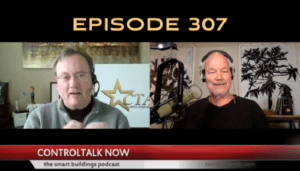
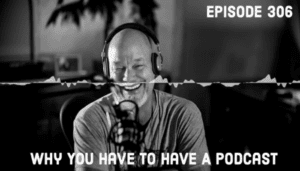
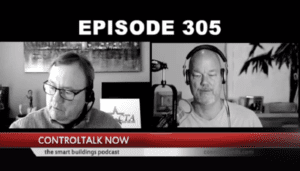



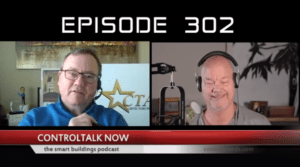



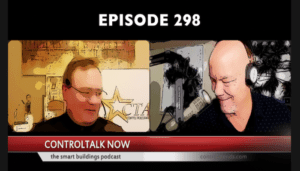
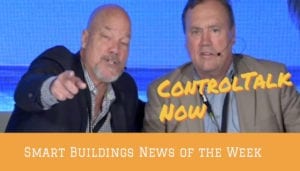

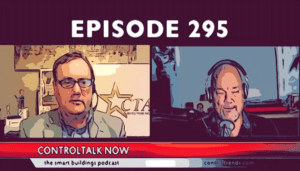



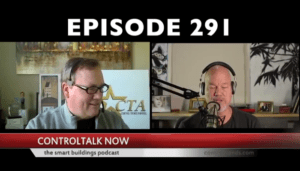


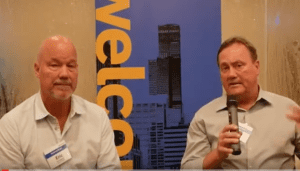






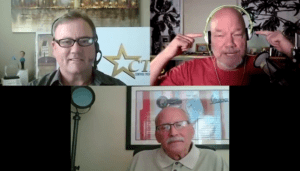
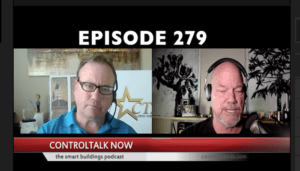
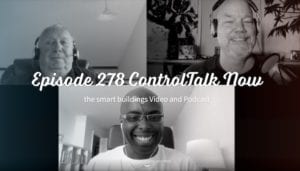


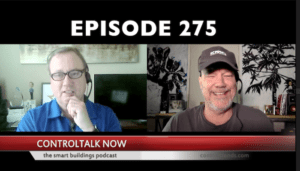


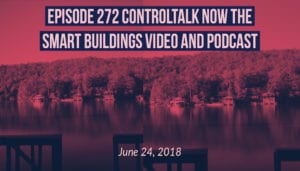
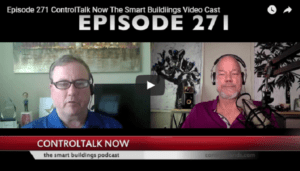



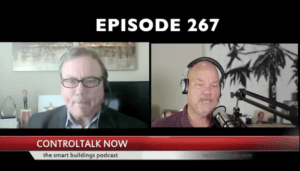

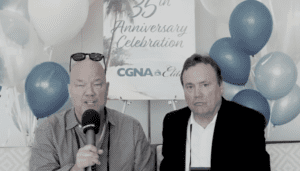

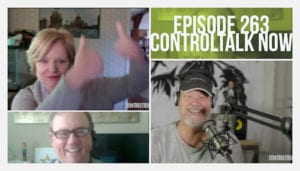
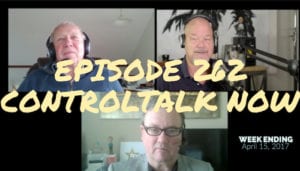
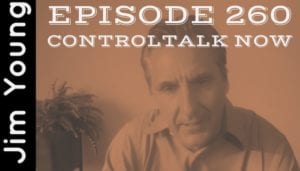
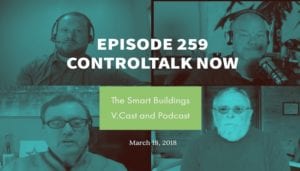





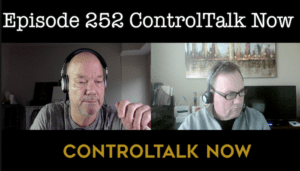
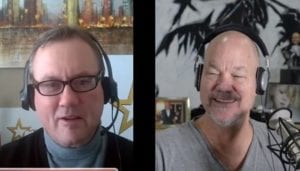


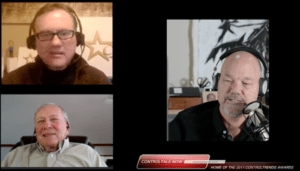
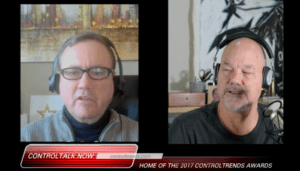
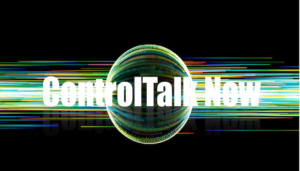
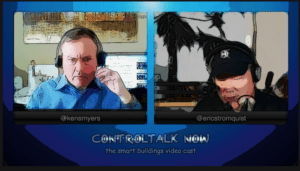


















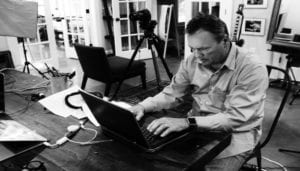

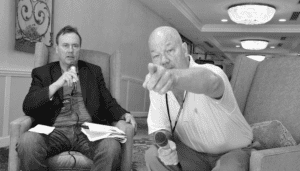
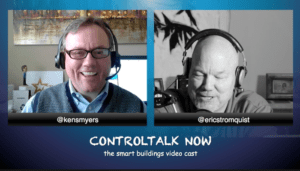
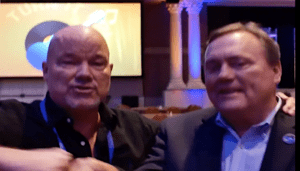



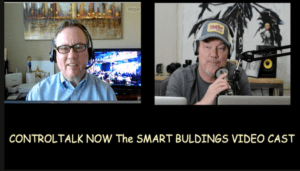

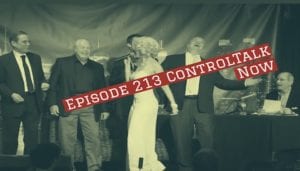
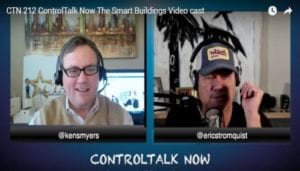



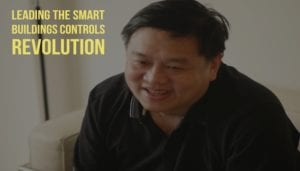
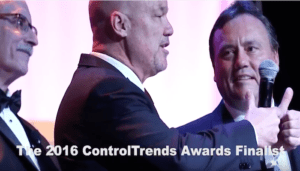

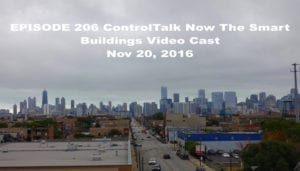

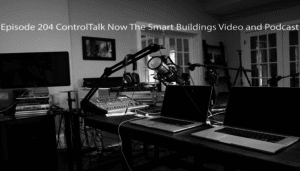
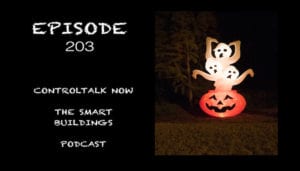
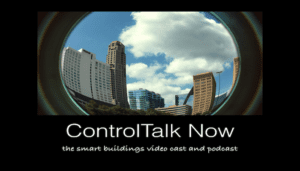

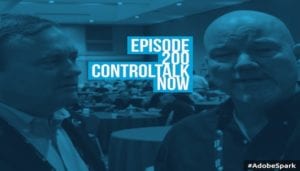

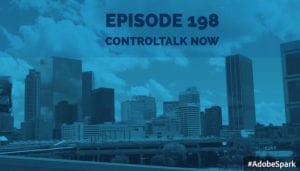

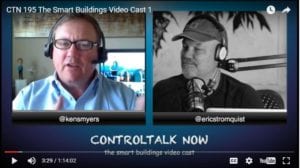
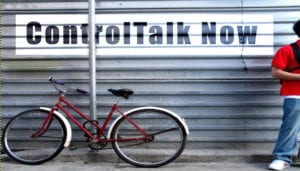
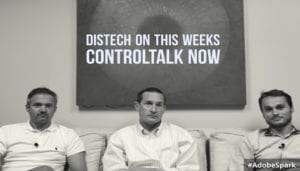

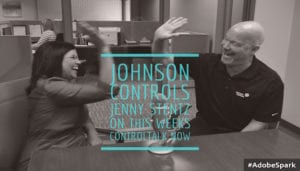
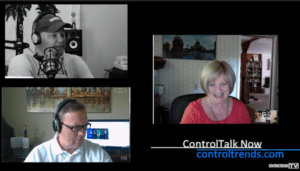


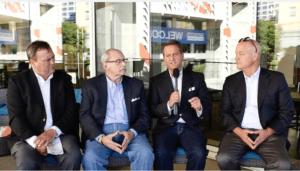

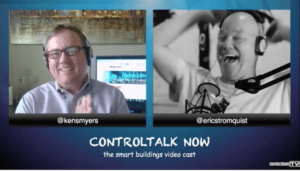
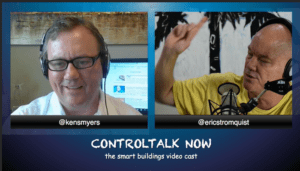



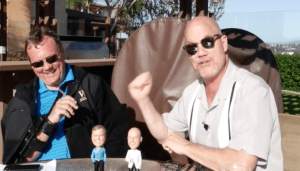



 BACnet® Router; CABA’s Intelligent Buildings & Digital
BACnet® Router; CABA’s Intelligent Buildings & Digital
